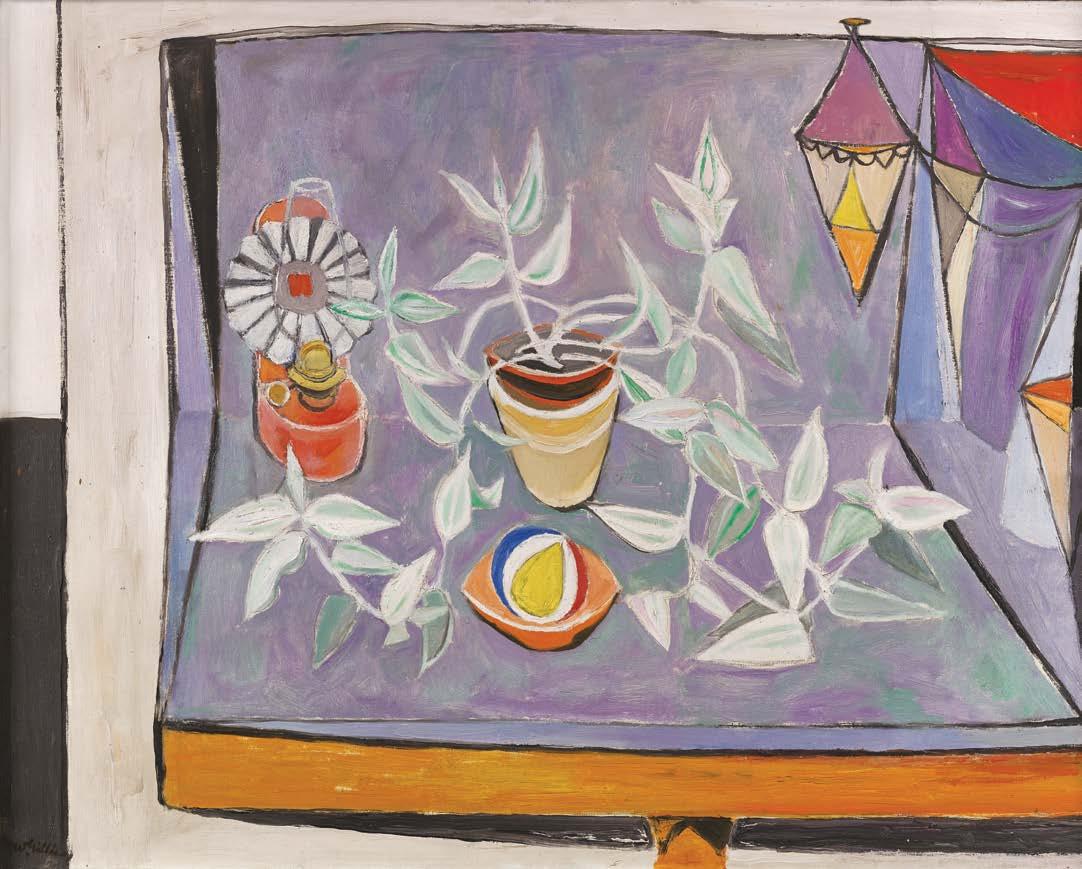A COLLECTOR’S EYE







Whilst our Modern Masters series has done much to highlight our unique history of artists and exhibitions, A Collector’s Eye marks the beginning of a new series accentuating the vital relationship between gallery, artist and collector. A Collector’s Eye brings together two private collections, paintings belonging to the late Professor Donald Eccleston and former director of The Scottish Gallery, David Lockhart. The art collection of Donald Eccleston is a personal insight into a life-long love of Scotland, its landscapes, people, and the artists who captured the country in bold, vivid brushstrokes. Over the years, he built up a collection of paintings by artists who worked at Catterline (a place familiar to the family when Donald was employed at Aberdeen University), which includes an important group of paintings by Lilian Neilson (1938–1998). He also acquired an exceptional example by Florence Jamieson (1925–2019), like Neilson an artist who was overlooked in her lifetime and is now receiving
an overdue reappraisal. The art collection of David Lockhart also reflects a life-long love of Scotland and its artists, some introduced to him through his association with The Scottish Gallery with many paintings acquired from our Festival exhibitions. He appeared in the 1985 BBC programme Morrison at Work alongside the landscape painter James Morrison (1932–2020) in front of View from Morar (cat. 47), explaining his familiarity and connection with the west coast of Scotland. Both collections are a celebration of lives well lived, surrounded by art which gave so much pleasure, each a way-marker in life, of time, place, and people. For The Gallery these returning works remind us how a collector is the benign, temporary custodian, providing another layer of provenance in the journey of a work of art which will be there long into the future.
the scottish gallery Opposite: Alberto Morrocco’s studio, Dundee, c.2017.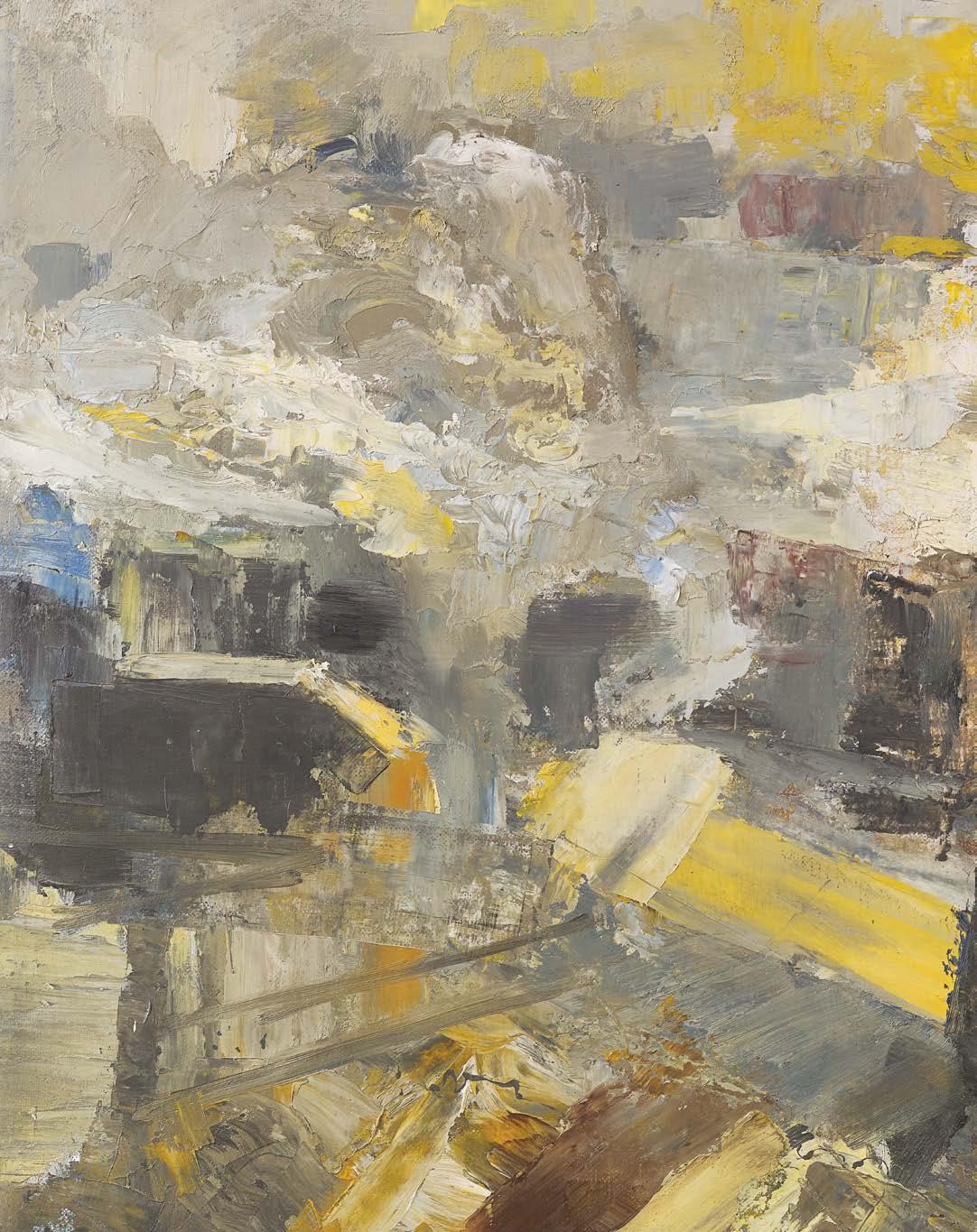

Above: Joan Eardley, Sunset Over Catterline, 1960–63, oil on board, 72 x 112 cm. Included in Ten Years of Modern Masters, The Scottish Gallery, January 2023

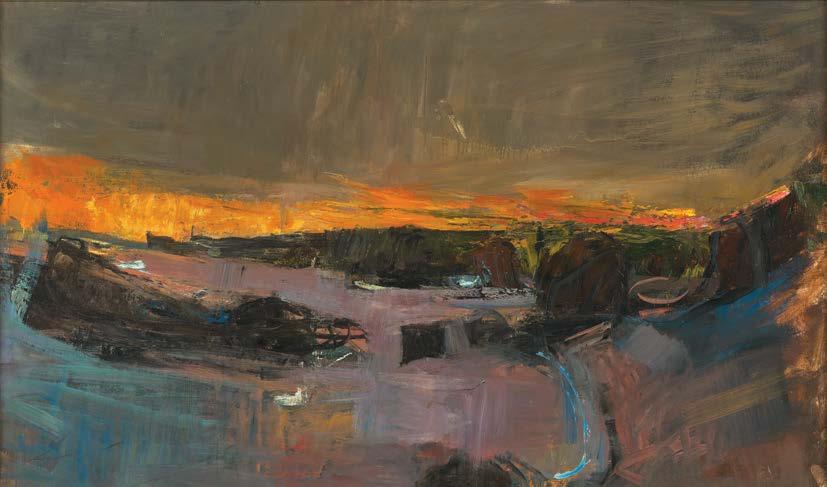 Right: Joan Eardley painting on the shore, Catterline, 1960.
Right: Joan Eardley painting on the shore, Catterline, 1960.
The art collection of Professor Donald Eccleston reflects a life-long love of Scotland, its landscapes, people, and the artists who captured the country in bold, vivid brushstrokes.
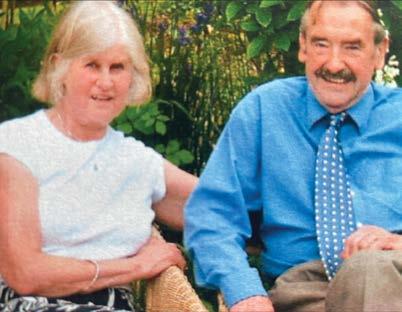
He was raised in Preston, Lancashire, in a modest bungalow with no art in sight. Paintings were an impossible luxury – hung in public galleries, or the homes of other people. By the time he retired in Newcastle, there were paintings on every wall – each a reminder of the places in Scotland that he lived or wandered. First, it was Aberdeen where he trained as a doctor – a granite city, of torrid seascapes and big skies so brilliantly caught on canvas by artists such as Lilian Neilson and Joan Eardley. Especially Eardley – one of her grand sunsets over Catterline Bay was his favourite artwork. It hung in the living room and he admired it every day, never taking for granted his luck to own it, for a while at least. Then there
was Edinburgh, where he raised his family with his beloved wife Maureen. The city was also the inspiration for artists including Anne Redpath, Anne Oram and David McClure whose earlier works were some of the first paintings he bought. Leaving Scotland for Newcastle to become Professor of Psychiatry was a wrench. But he surrounded himself with paintings that would remind him of what would always be his first home. The Borders and Western Isles where he’d fished. The mountains and riverbanks he’d trekked – in the footsteps of Duncan Shanks, Denis Peploe and John Houston. There are many still lifes in the collection too. Maybe they offered a serenity, some quiet escape from a busy work life. Or maybe he just liked them. He liked lots of things – fishing, fine wine, dogs, friends. And Scottish art was the backdrop to it all.
mark eccleston, 2023CBE,
exhibited Summer Exhibition, The Scottish Gallery, Edinburgh, 1979, cat. 99
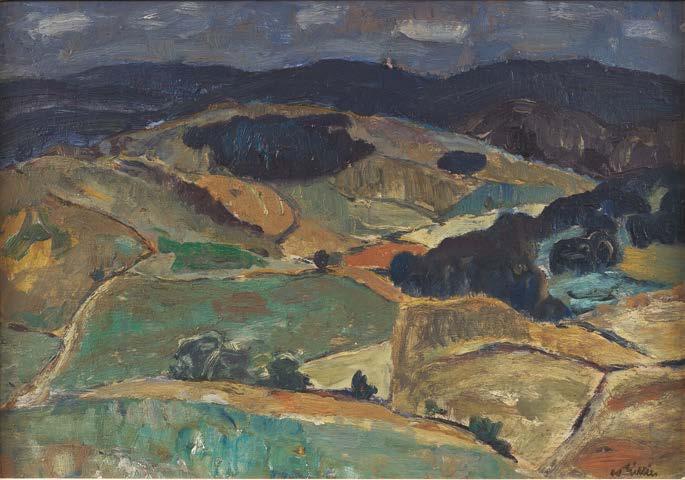 Sir William Gillies CBE, RSA, RA, PPRSW (1898–1973)
1. Border Hills, near Stow, c.1950 oil on board, 38 x 53.5 cm signed lower right
Sir William Gillies CBE, RSA, RA, PPRSW (1898–1973)
1. Border Hills, near Stow, c.1950 oil on board, 38 x 53.5 cm signed lower right
Sir William Gillies CBE, RSA, RA, PPRSW (1898–1973)
2. On Gala Water, 1957 watercolour, 25 x 35 cm
signed and dated lower right
exhibited Royal Society of Painters in Watercolour, Edinburgh; Mainhill Gallery, Ancrum, 2001

exhibited
 OBE, RSA (1918–2009)
Earl Haig OBE, RSA (1918–2009)
3. Flowers in a Window, c.1990 watercolour and pen and ink, 43 x 31 cm signed lower right
OBE, RSA (1918–2009)
Earl Haig OBE, RSA (1918–2009)
3. Flowers in a Window, c.1990 watercolour and pen and ink, 43 x 31 cm signed lower right
Earl Haig OBE, RSA (1918–2009)
4. Vase of Flowers, c.2004 watercolour, 54 x 35 cm signed lower right; title inscribed verso
exhibited Festival Exhibition, Mainhill Gallery, Ancrum, 2004; Perpetua Pope – Painter and Curator, The Scottish Gallery, Edinburgh, 2014, cat. 58

Nael Hanna was born in 1959 in Neneveh, Northern Iraq. At 19, Hanna entered further education before being drafted into the Army to serve during the Iraq-Iran War. Whilst in military service, he continued to paint and was awarded a scholarship by the Ministry of Education, Baghdad, which took his studies to Britain. In 1983, he undertook art and language courses in Southampton before being awarded a scholarship to study Fine Art at Duncan of Jordanstone College of Art, Dundee. In 1987, Hanna won a further scholarship to study at Hospitalfield Summer School, Arbroath, where he developed an enduring passion for the northeast of Scotland, particularly Angus and the Kincardineshire coastline. After graduating, he travelled to Florence to study before returning to the rural Angus countryside where he made his home and studio. He has also been a lecturer at Duncan of Jordanstone College of Art. Today, Hanna paints full-time and is inspired by a deep love of nature and the wild Scottish landscape.
I am inspired by water, sound and nature, being fascinated by the changing colours and shapes reflected in the sea, land and sky. I enjoy looking for the rhythms created in nature and hope to capture the force of the natural elements which dictate so much to the world that we live in. I spend a great deal of time observing the coastal landscape near my Angus home, and however much at times I feel that I should escape from this recurring subject, I am always willingly drawn back by its sheer beauty and magnetism.
nael hanna5. Autumn Winds over the East Coast of Scotland, c.1998 mixed media on board, 78 x 108 cm signed lower left
exhibited 137th Annual Exhibition, Royal Glasgow Institute, Glasgow, 1998, cat. 38
Nael Hanna (b.1959)
John Houston was renowned for evoking the character of a place through his expressionist style of painting. Growing up in Fife, he was stimulated by the different light and weather effects of the Scottish coastline. Houston remarked that he “might make certain features or colours more dominant for the mood or the light of the composition”. In Spring Landscape, Aberlady, Houston captures the tail end of a spring storm as it moves across fields and dunes in East Lothian. Alongside his wife, Elizabeth Blackadder, Houston exhibited with The Scottish Gallery from the late 1950s. He was honoured with a major retrospective at the Scottish National Gallery of Modern Art in 2005.
6. Spring Landscape, Aberlady, 1994 oil on board, 20 x 37.5 cm signed lower left; signed, title and date inscribed verso exhibited Corrymella Scott Gallery, Newcastle upon Tyne, 1994
John Houston, OBE, RSA, RSW, RGI (1930–2008)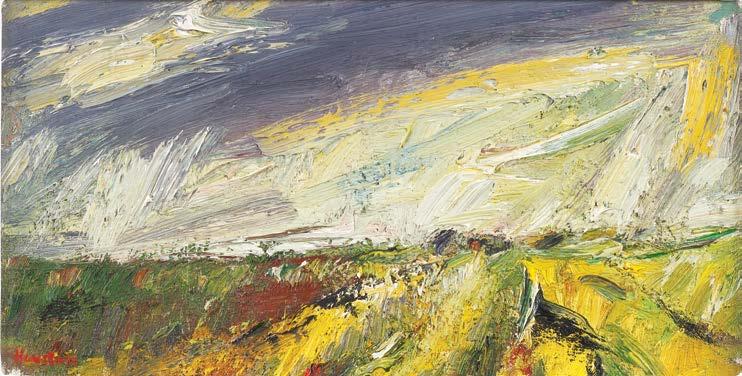
Caroline Hunter was born in Edinburgh in 1964, moving to the Orkney Isles with her family in 1968. She attended Aberdeen University and worked as an archaeological fieldworker for several years, throughout Scotland including Shetland and the Hebrides. She catalogued pottery for a year at the National Portrait Gallery in Edinburgh before returning to Orkney in 1992, where she began to paint. Her intimate knowledge of Scotland has given her studio practice a unique insight into the history of the landscape. In 2000, Caroline moved to Argyll, the inspiration for many of her sea and landscape paintings.
The soaring skies, building seas, bleached grasses against leaden hills, rusting tin roofs, brilliant greens of early summer and the roaring luminous surf at dusk in winter never lose their power and keep me reaching for my brushes.
Caroline Hunter (b.1964)
7. The Last Mackerel, c.2004 oil on board, 60 x 60 cm signed centre left; title inscribed verso

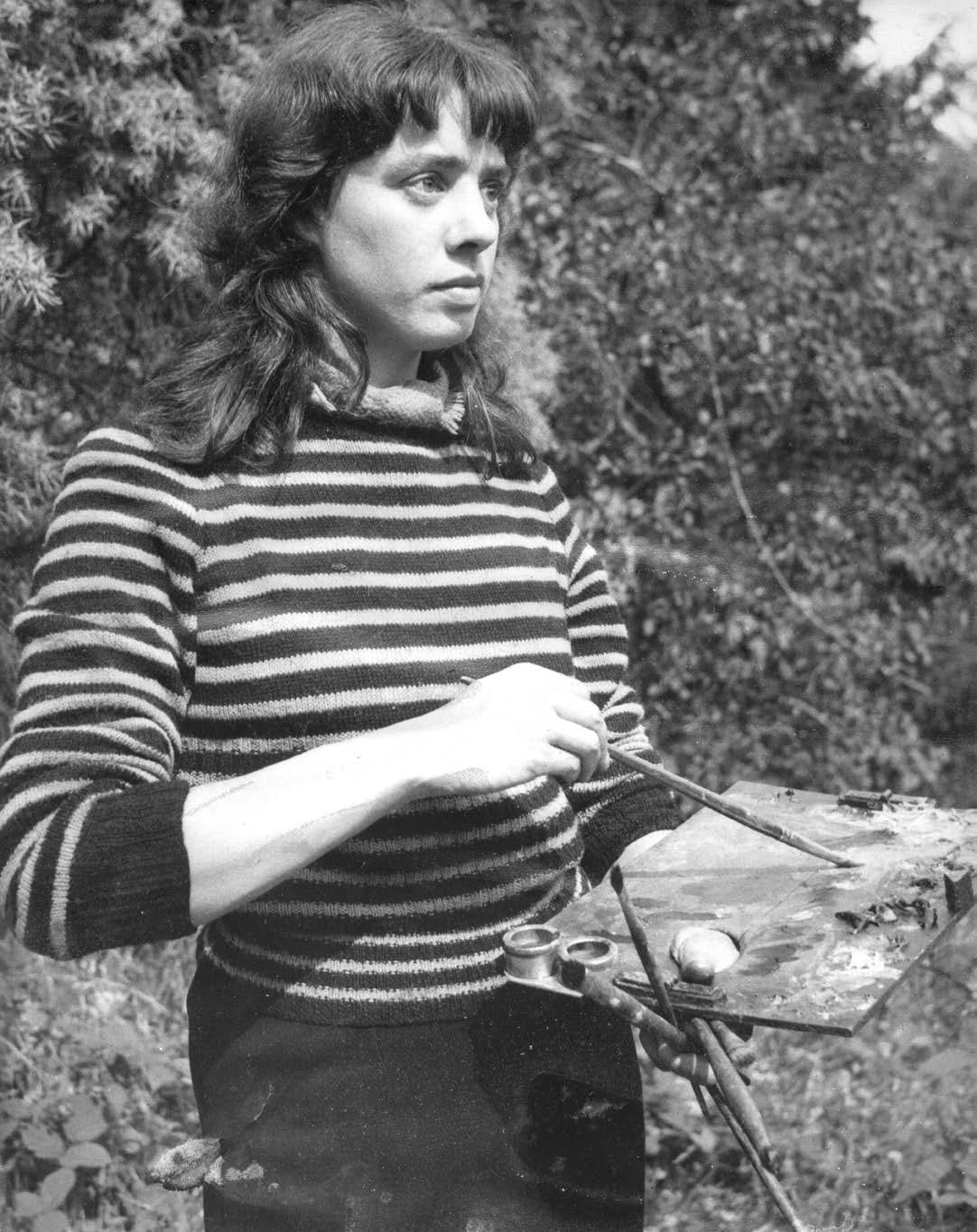
Florence Jamieson is considered one of the Glasgow Girls. Born in Glasgow in 1925 to a medical family with farming roots, she was evacuated to Morar in Lochaber during WWII where she attended high school for a few years before becoming head girl of St Trinnean’s in Galashiels. She began attending evening classes at the Glasgow School of Art. She met and married the artist Robert Sinclair Thomson, ARSA (1915–1983) and they set up a commercial pottery studio in their Glasgow home; the first of its kind in Scotland and now referred to as the Clouston Street Pottery. In the 1950s Florence built a successful exhibiting career, with solo exhibitions at The Scottish Gallery in 1958 and 1961. Working in Glasgow, she was a friend and contemporary to Joan Eardley and Margot Sandeman.
She moved to Inverness in later life. Jamieson’s distinctive paintings and drawings reflect a love of nature and close observation, finding inspiration in the things she saw around her, painting still lifes, landscapes and natural objects such as shells, wood and stones using mixed media. In 2014, she was one of four remaining living artists represented in the Glasgow Girls Kirkcudbright exhibition. Her work is represented in various public collections including Kelvingrove Art Gallery & Museum, the Hunterian Art Gallery, The Scottish Arts Council Collection, Gracefield Arts Centre in Dumfries, and the Scottish Fisheries Museum in Anstruther.
Painted a year or so before her Still Life with Mackerel, held in the collection of Glasgow Museums at Kelvingrove, Still Life with Fruit has the same strength of colour and freedom of application. Jamieson using the difficult water-based medium of gouache makes no attempt to disguise the marks of the brush nor to create conventional perspective. Her composition is low-lit, the colour jewel-like. A candle stub in its holder is perhaps recently extinguished, its glow still somehow present in the stygian corner of the studio. For comparison we have the late still lifes of Anne Redpath, but it is the originality of the colour composition, which is striking, marking Jamieson out as a unique talent: the Glasgow Girl who graduated into a modernist.
Florence Jamieson RSW (1925–2019)
8. Still Life with Fruit, 1958 watercolour and gouache, 38 x 76 cm signed lower right
exhibited The Scottish Gallery, Edinburgh, 1958; Mainhill Gallery, Ancrum, 2010
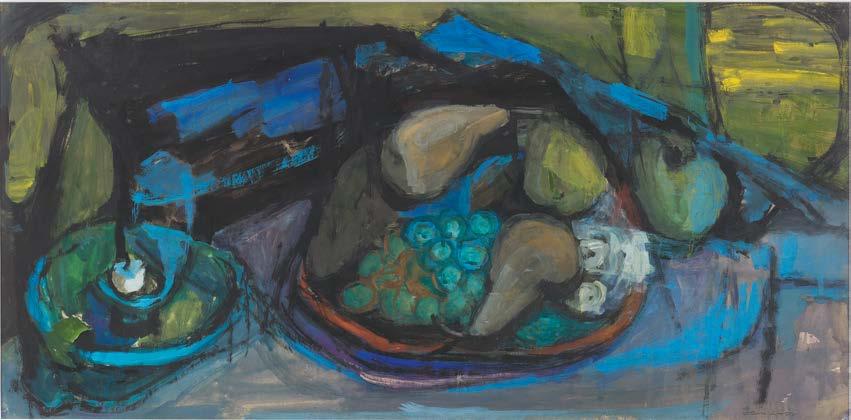
(1928–2018)
Sheila Macnab Macmillan was born in Glasgow in 1928. She attained a degree in Geography at Glasgow University and went on to train as a teacher. Her painting talent was encouraged by her artist uncle Iain Macnab RE ROI (1890–1967) who persuaded Sheila to come to London and train under him. Iain Macnab had been Principal at Heatherley's Art School (1925–1940) and became the founding Principal of the Grosvenor School of Modern Art. Sheila's London influences and Glasgow School foundations evolved into a distinctive and individual style. She usually worked en plein air and her work is semi abstract. She focused mainly on landscape where her training as a geographer, allowed her to use her understanding of land formation, the delicate balance of the seasons and explore the interaction between Man and the environment. She painted in Scotland, Spain, France and Italy and her work was widely exhibited in her lifetime.
Sheila Macmillan (1928–2018)
9. From Donnie’s Brae, c.1997 oil on canvas, 51 x 56 cm signed lower left
exhibited Art at the Royal, The Edinburgh Gallery, 1997
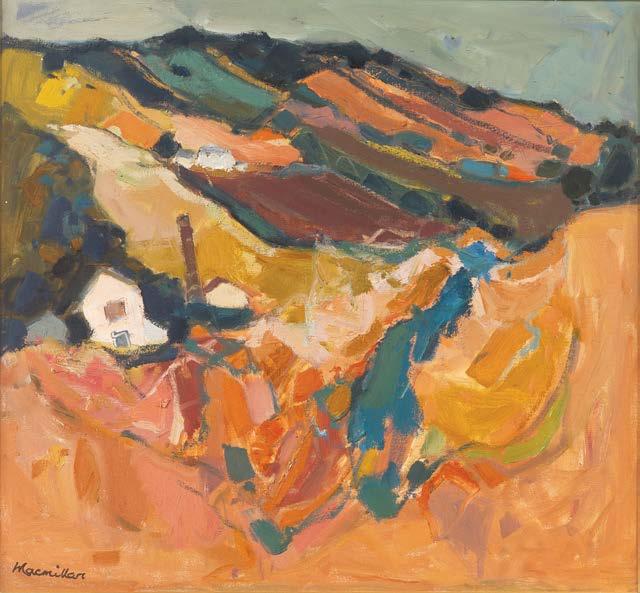

FRSE, RA, PPRSA (1903–1981)
Born in Loanhead, near Edinburgh, Sir William MacTaggart was the grandson of the renowned landscape painter William McTaggart (1835–1910). He studied alongside William Gillies at Edinburgh College of Art from 1918 to 1921 and travelled to Paris after graduating. He was one of the foremost Scottish artists who, before the War, moved away from the tonal painting and academic draughtsmanship towards a more personal spontaneous way of painting using the full resources of colour. He was the first of his direct contemporaries to exhibit with The Scottish Gallery, his first show being in 1929 and was a founding member of the 1922 Group. This early landscape captures the tone and atmosphere of a winter’s day in Midlothian, the late afternoon sun illuminates the high clouds with a peachy glow, whilst casting long shadows on the snowy fields.
Sir William MacTaggart FRSE, RA, PPRSA (1903–1981)
11. Winter Landscape, c.1925 oil on board, 30 x 35 cm signed lower left, studio stamp verso
provenance
The artist’s studio; St Andrews Fine Art
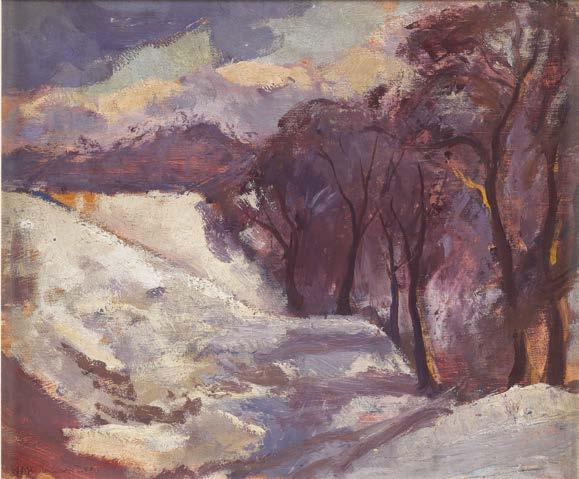
David McClure’s place in 20th century Scottish painting is in the first rank. As a young painter coming through Edinburgh College of Art in the 1950s he had an intellectual curiosity that gave rigour and intelligence to his artistic choices. However, his generous and gregarious personality and many common concerns kept him in sympathy with the senior figures of the Edinburgh School: Gillies, Redpath and MacTaggart. It is in the incisive quality of his drawing and original viewpoint that we see the character of his art develop.
Like all artists his mature style is a synthesis of influences, which include Robert Henderson Blyth, Robin Philipson and further afield Marc Chagall, Henri Matisse or George Braque. Anne Redpath must have been an influence on his palette and for a short time he also shared something of her technique, particularly with a palette knife. In common with Alberto Morrocco, his friend and colleague at Duncan of Jordanstone College in Dundee over twenty five years, in a later phase we see a pushing of colour towards further brilliance and drama. Painting in Sutherland and at home at Strawberrybank, we see a willingness to take risks that produced some of his finest oil paintings.
Like many painters of The Edinburgh School he divided his artistic output between oil painting and watercolour, as well as drawing constantly. He became a member of the RSW in 1965.

12. Flowers and Pear, 1987 oil on board, 20 x 25 cm signed lower left; signed, title and date inscribed verso exhibited Cyril Gerber Fine Art, Glasgow, 2005
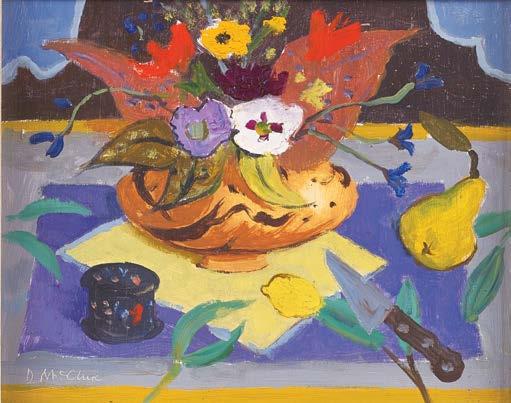 David McClure, RSA, RSW (1926–1998)
David McClure, RSA, RSW (1926–1998)
13. Flowers, Fruit and Vegetables – Malta, c.1991 oil on canvas board, 45.5 x 56 cm signed lower left; signed and title inscribed verso
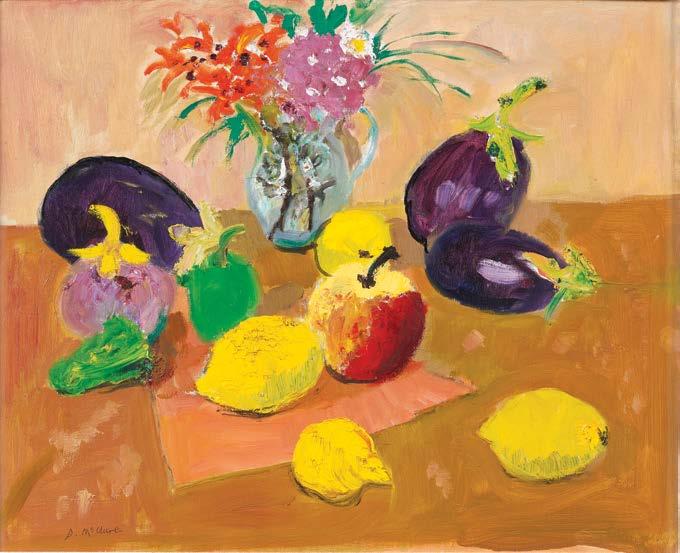 David McClure, RSA, RSW (1926–1998)
David McClure, RSA, RSW (1926–1998)
14. Moon by Day, 1992 oil and collage on board, 60 x 38.5 cm signed lower left; signed, title and date inscribed verso
 David McClure, RSA, RSW (1926–1998)
David McClure, RSA, RSW (1926–1998)
15. Flowers and Butterflies II, 1992 oil and pastel on board, 90 x 76 cm signed lower right; signed, title and date inscribed verso
exhibited Thackeray Gallery, London
 David McClure, RSA, RSW (1926–1998)
David McClure, RSA, RSW (1926–1998)
David McClure, RSA, RSW (1926–1998)
16. Flowers, c.1992 oil on canvas on board, 48 x 37 cm signed lower right; signed and title inscribed verso

David McClure, RSA, RSW (1926–1998)
 17. Flowers in a Small Jug, c.1994 oil on board, 36 x 23.5 cm
17. Flowers in a Small Jug, c.1994 oil on board, 36 x 23.5 cm
(1938–1998)
Lilian Neilson was underestimated as an artist during her lifetime and her contribution is only beginning to be fully appreciated. This rare and personal collection of paintings acquired by the Eccleston family offers another window into Neilson’s artistic practice and intimate knowledge of Catterline and the northeast. In Blue Sea, Catterline (cat. 20) the sea may be blue, but it is turbid under a stormy sky, a heavy oily swell generated far out in the wild North Sea. One can read Blue Boat, Catterline (cat. 21) as the artist’s immediate, emotional response to Joan Eardley’s passing, the previous August, painted in the winter of 1964. It is a powerful response to the wilderness they shared, where Neilson seems to inhabit the presence of her friend, to continue the engagement with a subject so dear to both. The fierce and fragile daily existence at Catterline is captured in White-Washed Cottages, Catterline (cat. 19); we can imagine the row of houses which overlooks the harbour and vast northeast sea being battered by a cold, biting and unrelenting wind. Moon and Tilly Lamp (cat. 22) and Spring Flowers (cat. 23) are rare examples of her interior life. Wildflowers grow in abundance during the summer, which offer a constant supply of flowers and Neilson’s composition fills the picture space, all perspective eliminated and her motif at once real and elusive.
In Moon and Tilly Lamp, the lamp has been posed on a cottage window ledge, its form and glow complementary to the shape of the new moon outside. Neilson’s impasto pulls across the rough board, a little tachism masterpiece inspired by a
real, observed conjunction. Morning Light II (cat. 18) provides an ethereal abstraction of Dundee, perhaps viewed from the harbour. The light is soft and diffused across the river city.
Born in Kirkcaldy, Lilian Neilson studied at Duncan of Jordanstone College of Art, Dundee (1955–60), followed by a brief period at Hospitalfield House in Arbroath, where she became friends with Joan Eardley (1921–1963). She completed a post-diploma year tutored by Hugh Crawford and Alberto Morrocco in 1960–61 and was awarded a travelling scholarship to France and Italy in 1961–62. Following this time in Europe, she joined Joan Eardley in Catterline where Neilson responded to the dramatic Northeast coastline and began painting powerful landscapes and seascapes. The artist also worked backstage with Reet Guenigault in theatres including the Traverse in Edinburgh and in England, returning to Catterline to help nurse Joan Eardley when her illness was diagnosed in 1962. Neilson bought one of the tiny fishing cottages, No 2 South Side, Catterline, with her home on one side and studio on the other. Like Eardley, she lived a frugal life. She moved permanently to Catterline in 1986 where Neilson undertook monthly surveys of the coastline and local beaches and began studying printmaking in Dundee. Her final exhibition, Certain Days and Other Seasons, was held at the Seagate in Dundee and Aberdeen Museum & Art Gallery. Neilson, known as ‘Lil’ to her friends, pronounced this to be the end of her life’s work, prophetically as it turned out, for by August 1997, the artist was terminally ill with cancer.
Lilian Neilson in her Catterline studio, c.1990.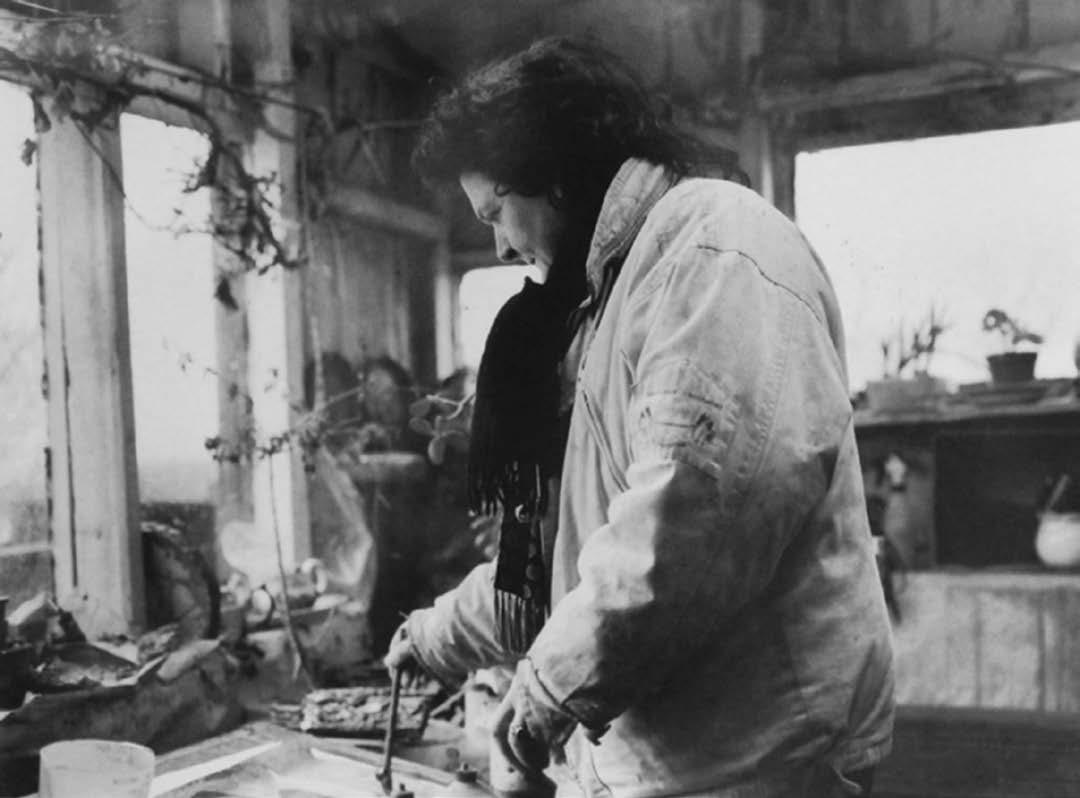
Lilian Neilson (1938–1998)
18. Morning Light II, 1961 oil on canvas, 71 x 86 cm artist’s name, title and date inscribed verso

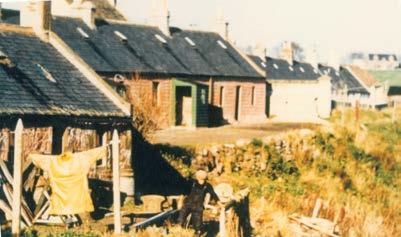
19. White-Washed Cottages, Catterline, 1968 oil on board, 41.5 x 65 cm
signed and dated lower left
exhibited Into the Light, Aberdeen Art Gallery and Museums, 1999, cat. 14
The Row, Catterline, c.1963.
Lilian
20. Blue Sea, Catterline, c.1967 oil on board, 37 x 61 cm
 Neilson (1938–1998)
Neilson (1938–1998)
 Lilian Neilson (1938–1998)
Lilian Neilson (1938–1998)
Lilian Neilson (1938–1998)
22. Moon and Tilly Lamp, c.1967 oil on board, 27 x 23 cm
exhibited Mansfield Park Gallery at The Glasgow Art Fair, 2004

Lilian Neilson (1938–1998)
23. Spring Flowers, c.1965 oil on board, 54.5 x 37 cm
exhibited Mansfield Park Gallery, Glasgow, 2003
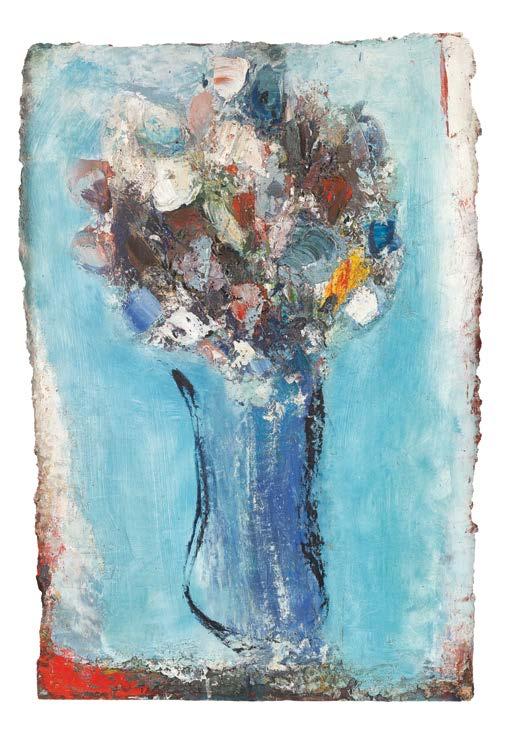
Ann Oram was born in London in 1956. She studied at Edinburgh College of Art between 1976 and 1982 and became a part-time lecturer at the College in the 80s and 90s. She was elected to RSW in 1986. Ann Oram’s first exhibitions with The Gallery were exotic, rich urban landscapes: buildings familiar and foreign invested with character and mystery. Her subjects range around Scotland, in France, Italy and Spain and she continues to paint the interior with still life; flowers both cut and gathered, objects collected, like Anne Redpath before her, from her travels and keen eye for shape and form.
Ann Oram RSW (b.1956)
24. Sitting at the Table, 1993 oil on card, 58 x 42 cm signed and dated lower middle exhibited Corrymella Scott Gallery, Newcastle upon Tyne, 1994
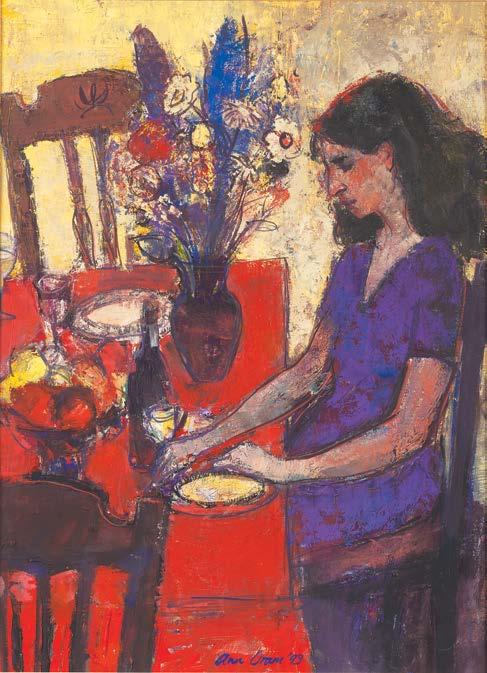
Denis Peploe was born in Edinburgh in 1914. He was the second son of Samuel John Peploe and his wife Margaret. At seventeen he enrolled at the Edinburgh College of Art in the same year as Wilhelmina Barns Graham and Margaret Mellis and took to College life, fulfilling early promise to win post-Diploma scholarships to Paris and Florence and then extensive travel in Spain, Italy and Yugoslavia. In Spain he witnessed political turmoil turn to War and before he had had a first one-man show, Europe was at war again and the young painter found himself in uniform. He began as an enlisted soldier and finished as a Captain in SOE (Special Operations Executive). He could have stayed on in ‘The Service’ but instead returned to Edinburgh to pick up his brushes. Perhaps not surprisingly as he started to paint again it was to the West Highlands he was drawn. Just as his father had written to his friend Cadell, convalescing in France in 1917, of how they must go to Iona, to find their innocence again, the wilderness of Knoydart and Applecross had a visceral appeal to the War-weary. No surprise either that his first exhibition, in June 1947, was with The Scottish Gallery. The critical reception was very positive, one paper recording: “I cannot remember any young artist getting such notices for a first exhibition. The Scotsman critic wrote of “the great richness and vigour of the work; the Glasgow Herald said he was an artist born fully armed; and The Bulletin critic wrote “the general impression of the exhibition is that we have in Denis Peploe a vital and adventurous painter.”
He showed again a year later and in 1950 and received much more positive reaction from his first London show with the prestigious Hazlitt Gallery in 1952. He showed at Annan in Glasgow the following year and with The Scottish Gallery again in 1954. This was an outpouring of work after the frustration of six years of active service; life opened up for Peploe. He had a new studio in Church Lane,
the art master’s position at Fettes, a circle of friends who included artists and poets and the possibility of travel. One friend, Dr John Guthrie and his wife Vivien, herself the daughter of the painter John Duncan, moved to Kyrenia in Northern Cyprus and Peploe made an extended trip in 1951 as evidenced by work in his exhibitions in the early 1950s. He also returned to Spain in 1950, to San Feliu and then Peniscola in 1955 and with his wife Elizabeth on an extended honeymoon based in Cuenca in 1957. With marriage and his position at Edinburgh College of Art, where he began in 1954, life took on a settled pattern and although he did not stop painting he did stop exhibiting, beyond his yearly entry for the Summer Exhibition at the RSA where he became an associate in 1956. Painting was a true vocation for Peploe, he had a modesty that bordered on diffidence and unless persuaded out, he remained a private person content with family and studio. He was sensitive to comparisons with his father and signed his pictures Denis P to avoid any possible confusion. His reviews never avoided mention of his father but always credited the younger Peploe as being his own man, and this is true; one could never be confused with the other. However, they had a very similar approach: each picture was a response to a particular subject, either intellectual or emotional: responses to the conundrum of a still life composition or the demands of a particular day in the landscape. Stylistic variety – from a rich impasto applied with a palette knife for the rugged hillside of Tarskavaig to thin glazes to capture a misty vista at Ambleside – is always made to serve the emotional truth of the subject. In his later career, exhibitions at The Scottish Gallery saw a late flowering of talent with his last three exhibitions receiving rave reviews and despite the accolades, my father remained modest throughout his life.

A curious collector in possession of a west highland oil painting by Denis Peploe wrote to the artist requesting a location for the picture – the artist did not tend to give too much away in a title. He was gratified with a six figure map reference and a bearing, the artist had after all been in the Commandos during the War and his plein air landscape was always true to place, geographical and spiritual. In 1947 Peploe was getting going again after the hiatus of the War years and a return to the Highlands and Islands seemed the best place to find himself again as a painter. His friends Torquil and Isobel Nicholson had removed to Plockton from Queen Street in Edinburgh and he had a ready second home from whence to get
to work. Today we cannot apply to Peploe for an exact location, but this title suggests we are looking towards Skye rather than camped on it and it may well be the view from Kyle. It is a fine, typical example of the wilderness of rock and sea under a heavy sky. Eighty years or so before Denis Peploe painted The Machair Shore, Barra (cat. 28) (perhaps using the same pochade painting box) Sam Peploe painted the same scene on the Atlantic beaches of Barra. My father captures the same sunshine and strong winds, the brilliant whites of the sand and menace of a dark sky.
guy peploeDenis Peploe, RSA (1914–1993)
25. Storm Clouds over Skye, 1947 oil on canvas, 41 x 46 cm signed lower left
provenance
The Scottish Gallery, Edinburgh, 2011
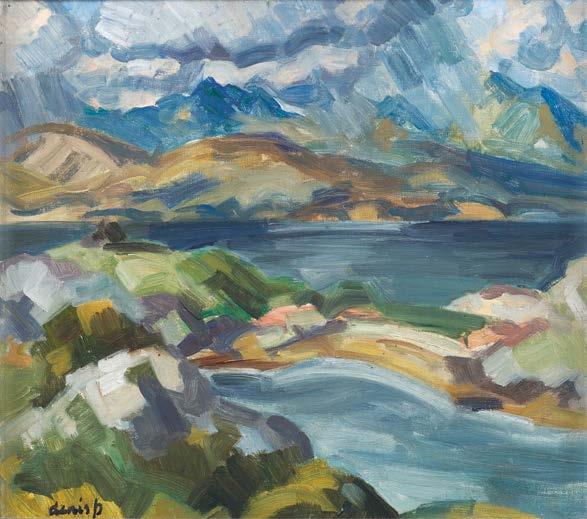
Denis Peploe, RSA (1914–1993)
26. Birds and Flowers, 1964 oil on canvas, 63 x 76 cm signed lower left; title inscribed on labels verso
exhibited
Denis Peploe – Paintings from an Artist’s Studio, The Scottish Gallery, Edinburgh, 1984, cat. 21; Denis Peploe – Centenary Exhibition, The Scottish Gallery, Edinburgh, 2014, cat. 7
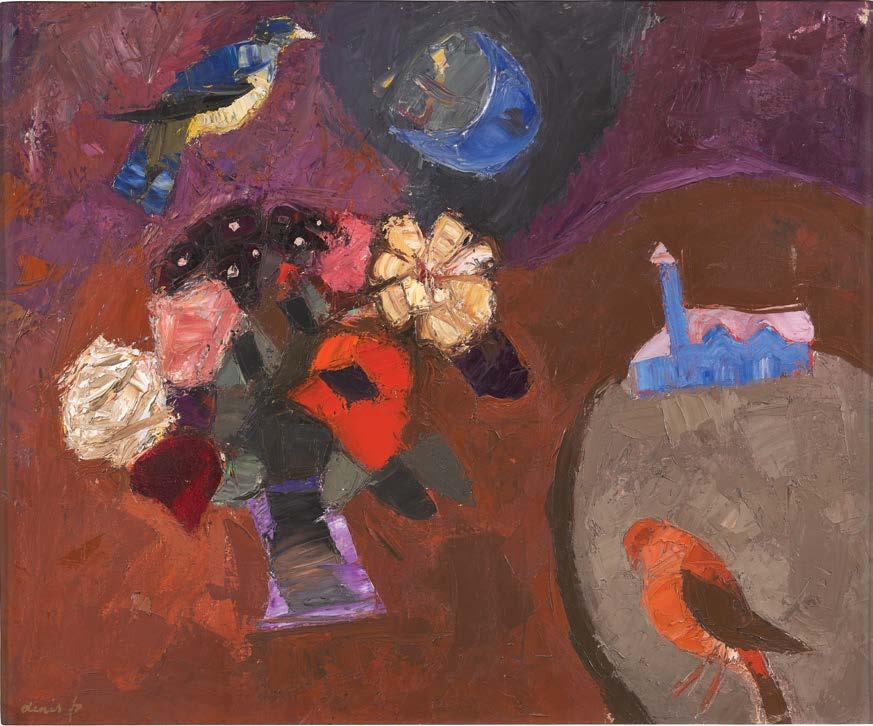
27. Still Life with Flowers, c.1975 oil on canvas, 61 x 48 cm signed lower right
exhibited Spring Collection, The Scottish Gallery, Edinburgh, 2012
Peploe, RSA
28. The Machair Shore, Barra, c.1989 oil on panel, 25.5 x 33 cm signed lower right; signed and title inscribed on artist’s label verso exhibited New Acquisitions, The Scottish Gallery, Edinburgh, 2007, ex.cat.
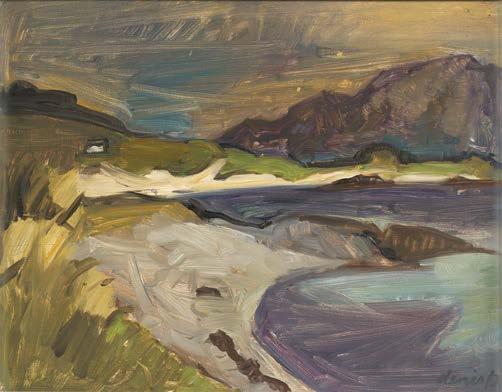
29. In Glencoe, c.1985 oil on board, 33 x 40.5 cm signed lower middle
exhibited Denis Peploe – Oil Paintings, The Scottish Gallery, Edinburgh, 1988, cat. 44

PPRSA,
RA, FRSE, RSW (1916–1992)Born in Lancashire, Robin Philipson attended Edinburgh College of Art from 1936–40 before serving with the King’s Own Scottish Borderers in India and Burma. On his return to Edinburgh, he joined the staff of the College, and was appointed head of School of Drawing and Painting in 1960, a post he held until his retirement in 1982. This early still life painting shows the influence of the Austrian painter Oskar Kokoschka, who was a great source of inspiration to Philipson during the
early 1950s. For Philipson, Kokoschka’s energetic handling of paint and high colour were an enduring influence that enabled him ‘to create the kind of vitality and compressed energy that I was looking for.’ Philipson’s first exhibition at The Scottish Gallery was held in 1956, the first of nine during the artist’s lifetime. He was doubtless the most highprofile Scottish artist of his generation, serving as President of the Royal Scottish Academy and was honoured with a knighthood in 1976.
Sir Robin Philipson PPRSA, RA, FRSE, RSW (1916–1992)
30. Still Life with Fruit, c.1954 oil on board, 25 x 35 cm signed lower left

John Piper was born in 1903 in Epsom Surrey and was an English painter, printmaker and designer. He is regarded as one of the early neo-romantic painters and a popular post-war artist. His practice encompassed the British landscape, especially the churches and monuments. He lived at Fawley Bottom in Buckinghamshire near Henley-onThames. He was educated at Richmond School of Art and the Royal College of Art, London. Piper was an official war artist in World War II between 1940–1942 and his wartime depictions of bomb-
damaged churches and landmarks, most notably those of Coventry Cathedral, made him a household name and led to his work being acquired by many public collections. He enjoyed a collaborative approach to his work, working with the poet John Betjeman, the potters Geoffrey Grigson (on the Shell Guides) and Geoffrey Eastop, and Ben Nicholson. In his later career he went on to publish limited edition signed prints. Piper wrote widely about modern art, and with his wife Myfanwy Piper founded the contemporary art magazine Axis
John Piper (1903–1992)
31. Foliate Head, c.1971 ink on paper, 39 x 57 cm signed lower right

Anne Redpath was the pivotal figure in the group of painters now referred to as The Edinburgh School. She had attended the College of Art, receiving her Diploma in 1917 but marriage and motherhood and residence in France where her husband worked as an architect attached to the War Graves Commission brought a working hiatus and a later flowering of her full talent. When she returned to Hawick in the mid-1930s, the landscape was her first inspiration: winter light, bare trees and the stolid architecture of The Borders. In her studio she painted a few memorable figure compositions and increasingly the tabletop still lifes which were to make her reputation and, as an independent woman without other means, her livelihood. Her palette was at first muted and there is both a delicacy in application and mastery of pale tones and jewellike colour notes, which recall something of Allan Ramsay.
In the 1950s and until her death in 1965 she travelled extensively, hugely enriching the scope of her subject-matter; always bringing back exotic objects for the studio and sketchbooks full
of material for oils. Like most of the Edinburgh School she divided her output between oil and working on paper, valuing each equally. Latterly in her flowers, landscapes and church interiors her treatment became more abstract as she abandoned conventional spatial composition. Her palette and technique developed also: she employed a knife as much as a brush and used rich and brilliant colour to make the distinctive, powerful oils of her maturity.
Redpath was an inspirational person and formed many enduring friendships. Her flat in London Street became an artistic salon, celebrated by Robin Philipson’s famous, affectionate group portrait in The Scottish National Portrait Gallery. She had considerable commercial success in her lifetime enjoying a fruitful, consistent relationship with The Scottish Gallery and latterly with Reid & Lefevre in London. Since her passing, her reputation has been further enhanced with retrospective and recent centenary exhibitions so that she is now established as one of the great figures in 20th century Scottish painting.
Anne Redpath at her Edinburgh home, 1960. Photograph courtesy of the Artist’s family
Like most of the painters who make up the loosely defined group of the Edinburgh School, Anne Redpath divided her time between oil and watercolour, or gouache. On paper not just as an expedient when painting outdoors, but in the studio also. Like her later oil still life her centralized motif in our work floats in secular mandorla her fruit subject freely painted but perfectly rendered.
32.
watercolour
signed lower left
provenance
Aitken Dott & Son, The Scottish Gallery, Edinburgh
Anne Redpath OBE, RSA, ARA, RWA (1895–1965) Still Life with Green Bananas, 1958 and gouache, 55.5 x 61 cm
RSA, RSW, RGI (b.1937)
Duncan Shanks was born in Airdrie and studied at Glasgow School of Art in the late 1950s where he later lectured. Shanks has lived in Crossford in the Clyde Valley for over 50 years and draws his subjects and inspiration from the countryside around his home. For Shanks, it is the act of looking which is the driving force behind his art, by observing and experiencing nature every day it allows him the chance to witness moments that he will have never seen before. This painting will have been made from one of the high hill tracks above his home, the physical brushstrokes and strong colour evoking the energy of a raging storm.
Duncan Shanks RSA, RSW, RGI (b.1937)
33. Wild Night, c.2009 acrylic on paper, 38 x 41 cm signed lower right
exhibited
Duncan Shanks – In Search of Time Past, The Scottish Gallery, Edinburgh, 2009, cat. 30
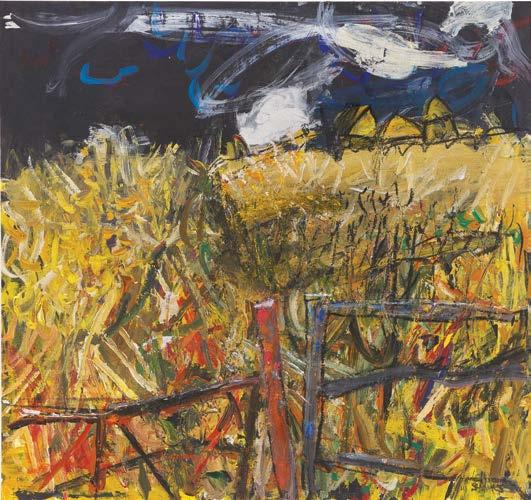
Annette Stephen was born in Aberdeen and went on to study at Edinburgh College of Art, before moving to France preceding the outbreak of WWII. After returning home, she taught art in the Aberdeen area before buying the ruined customs watchhouse perched on the clifftop at Catterline, near Stonehaven in 1950. The Watchie became her studio and allowed her the freedom to practise painting. Although born in Aberdeen and raised in Stonehaven, she lived in the tiny neighbouring, village of Catterline virtually all her adult life, after marrying Jim Stephen, a local fisherman.

Annette introduced the young Joan Eardley to Catterline in 1951. Eardley instinctively shared Annette's passion for Catterline, spending much of her time there until her untimely death in 1963. The artist Lil Neilson would move to Catterline in the early 1960s at Joan Eardley’s encouragement and she too was driven to create her own strong and emotive works, capturing the atmosphere and moods of the ever-changing elements surrounding this remarkable little fishing hamlet. Although they worked independently, and with very contrasting styles, Annette and Lil were close friends and each lent a legacy of paintings which have created a remarkable record of their village and the northeast coastline.
Annette Stephen’s watercolours are lively and expressive, with a strong emphasis on light and vibrant colour. Her style was uncomplicated, and
she produced assured work which captured both mood and place with extraordinary accuracy. Her paintings depicted subjects close to the artist’s heart, reminding us of her fondness for east coast fishing boats and harbours, the landscape of Kincardineshire and Deeside, and particularly of her home village, Catterline. Annette exhibited regularly in Scotland. This was an artist who lived a simple, modest life as a painter, and she was content that her paintings provided enjoyment for others. Annette was a wonderfully resilient and independent character, friendly and approachable (she made a very fine broth!).
Paintings by a Catterline Artist, 2003
Annette Stephen painting in Catterline, 1970. Photograph courtesy of D.C Thomson & Co Ltd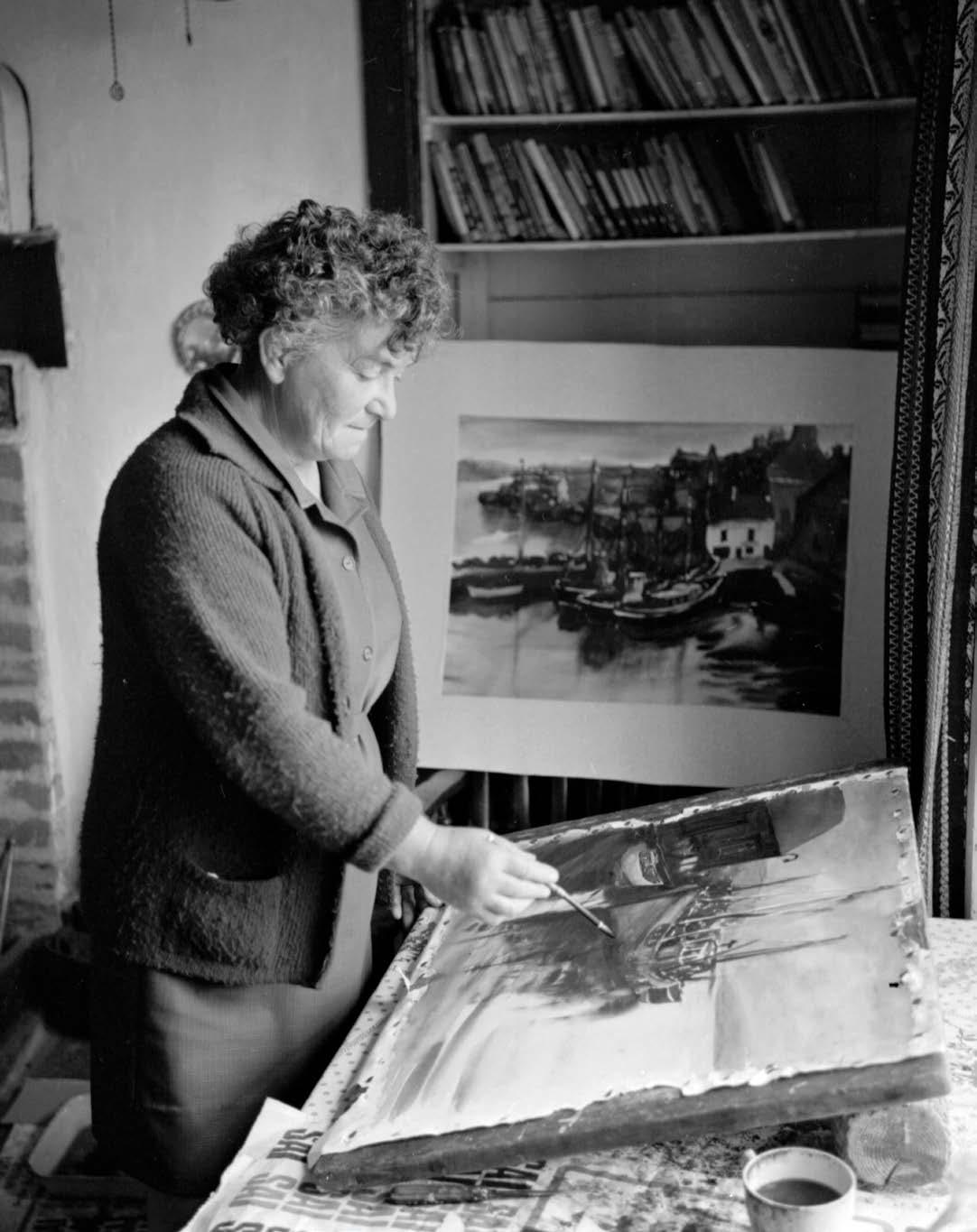
34. Storm Sky, St Cyrus, c.1970 watercolour, 30 x 48 cm signed lower right
 Annette Stephen (1911–1991)
Annette Stephen (1911–1991)
35. Mist Over Catterline, c.1970 watercolour, 37 x 54 cm signed lower right
 Annette Stephen (1911–1991)
Annette Stephen (1911–1991)
OBE, RSA, PRSW
Adam Bruce Thomson was a painter of great integrity whose long, productive life tells a story of Scottish painting for the first three quarters of the 20th century. Writing for the journal Scottish Art and Letters in 1946, when JD Fergusson was Art Editor, T Elder Dickson describes the artist: Thomson is a painter of uncompromising sincerity. Few artists contemplate a higher purpose or spare themselves less in striving after its fulfilment. Fastidious in all that pertains to his craft, he belongs by temperament and mental equipment to the central stream of European painting initiated by Giotto and revitalised by Seurat and Cézanne. In other respects, especially in his love of colour and fine craftsmanship he is thoroughly Scottish. He exhibited regularly with The Scottish Gallery throughout his career and he will be the subject of an exhibition at The City Art Centre, Edinburgh in 2024.
Winter Twilight painted in 1961 was first exhibited at the Royal Scottish Academy. It depicts a still life in front of the window of his home in the Braids in Edinburgh. The red cyclamen would have been chosen by his wife marking the winter season.
Adam Bruce Thomson OBE, RSA, PRSW (1885–1976)
36. Winter Twilight, c.1961 tempera on board, 51.5 x 61 cm signed lower left
exhibited Royal Scottish Academy Exhibition, Edinburgh, 1961, cat. 468; Summer Exhibition, The Scottish Gallery, Edinburgh, 1996
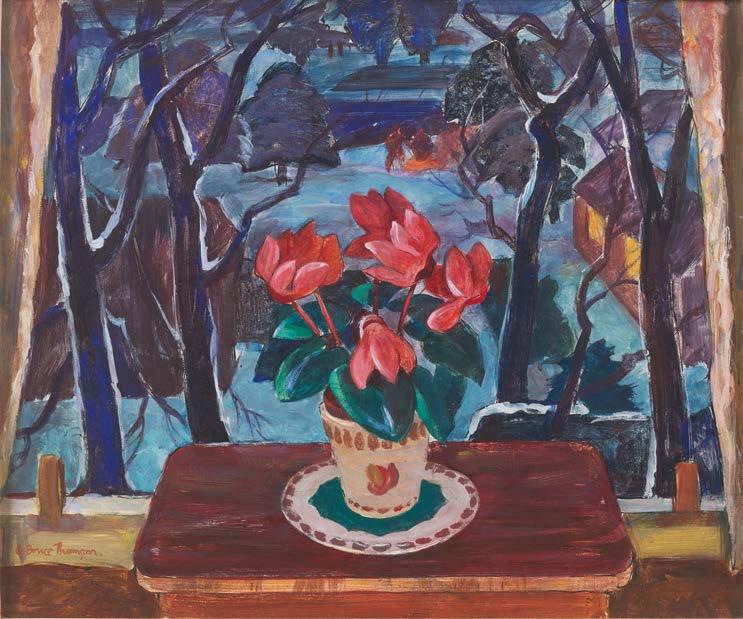

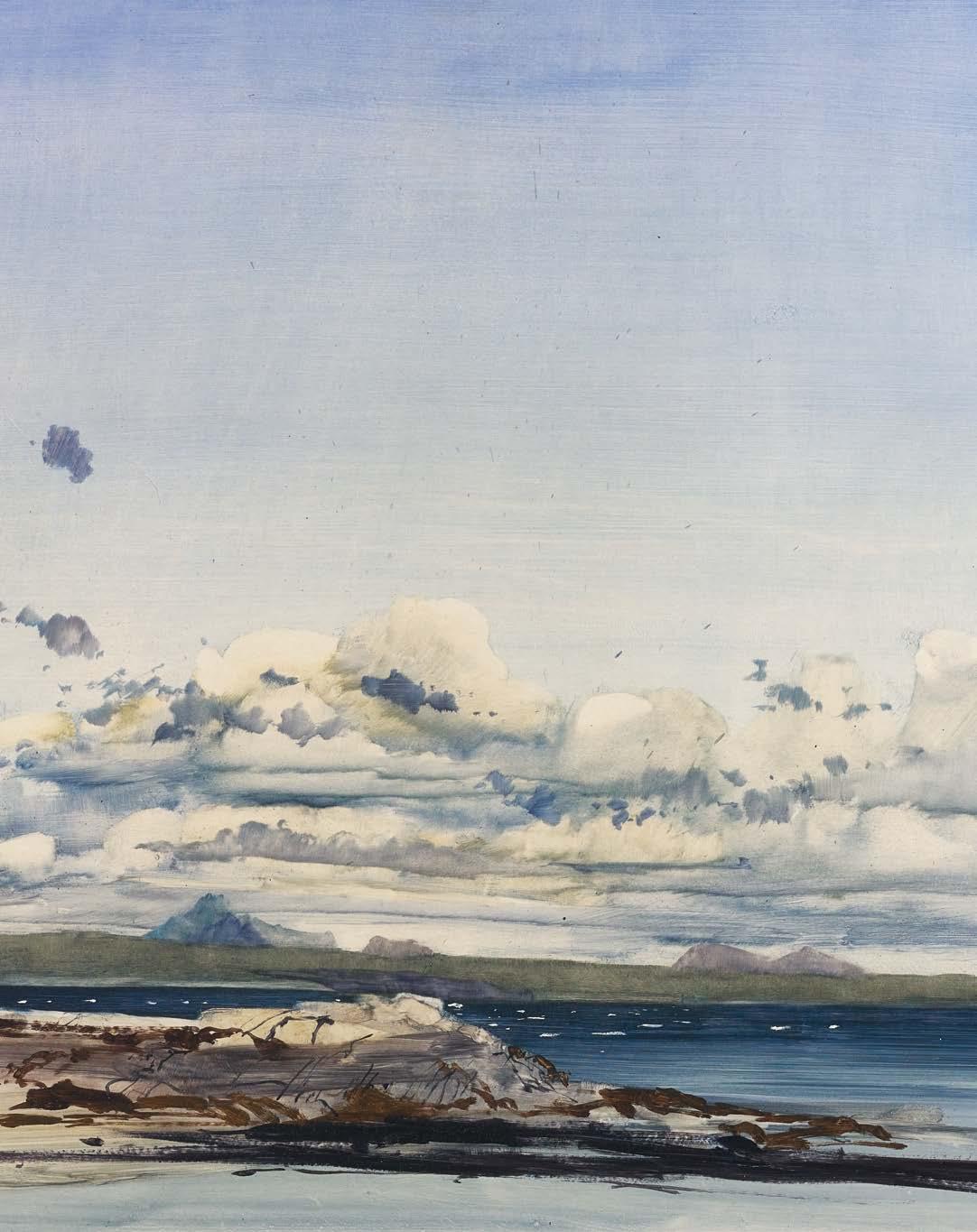
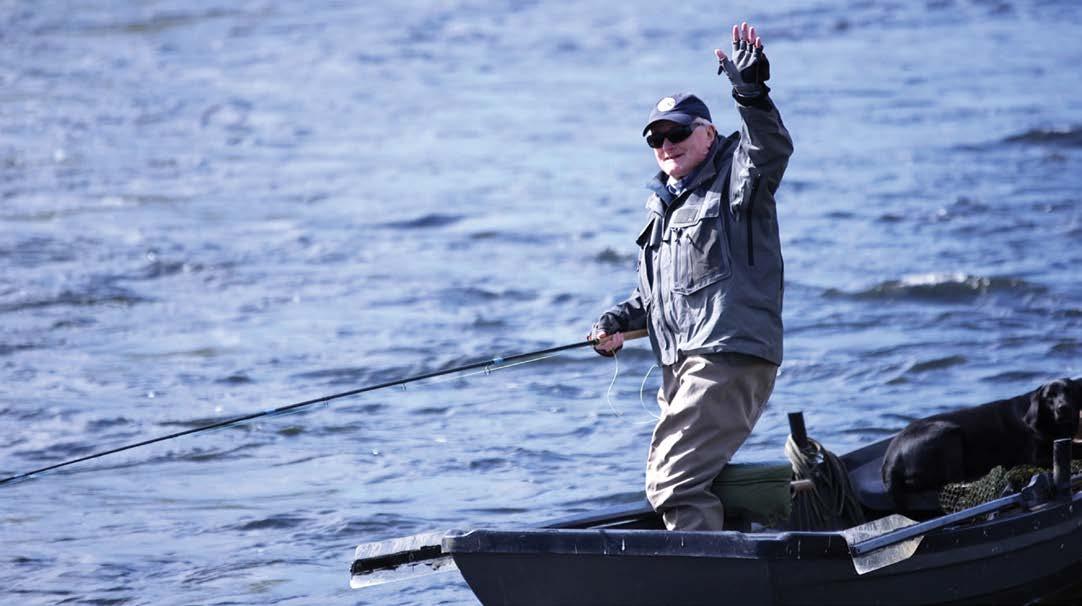
David Lockhart was born in Ayr in 1943 and went on to qualify as both lawyer and accountant. These qualifications, combined with a passion for life, a cool head and a charisma to burn, readied him for a career in business. He was already an avid collector of art when he was approached by Bill Jackson of The Scottish Gallery which was seeking investment for expansion in 1984. The company was incorporated (having existed as a partnership for the first 142 years) and David’s property company Caltrust became a significant shareholder and David a provider of business advice and acumen.
As a collector he loved strong colour and design and was fascinated by the background to a work of art he might acquire. He loved the landscapes and colours of his beloved Scottish countryside and his art took that love with him around the world. Art always looked fabulous in his various homes but was never bought as decoration; he was passionate about his collection and derived huge pleasure from its possession and contemplation. As a buyer he set aside his prodigious negotiating instinct, relying on The Gallery to give a fair price based on trust and longevity of relationship. People mattered
with David and his business decisions were always sealed with a handshake.
After the Gallery, David concentrated again on his core business in property, floating Halladale on the AIM market in 2001, and then building NewRiver REIT plc with his son Allan over the last ten years of his life, taking that business to a FTSE 250 listing and securing a Lifetime Achievement Award for services to the Property Industry.
David was a tall, open-faced individual, strikingly good looking. As a youth in Ayr a friend recalled his nickname as DAZ, a play on his initials after the best loved washing powder of this time! It was a nickname that stayed with him throughout his life: by name and by nature. Later another friend recalled him as a Viking-like figure in business, the dominant presence in any meeting. He reconnected with The Gallery in the last years of his life, the acquisitive art-lover re-emerging before his death, far too early in the midst of the pandemic in September 2020.
guy peploeRSW,
There is no shortage of subjects within a few miles of Crawford's home in Arbroath. He is attracted to the marchlands where sea meets land, where low buildings are scoured by wind and sand, where a lighthouse gives succour to a seafarer's eye, where the chance order of a row of seagulls or reflection on a cottage window makes us pause, think and wonder. He paints the wilderness of the North Sea, lent significance by the fisherman's blood that runs in his veins.
guy peploe, 1998
37. Snow Light, 1982–83
watercolour, 53 x 74 cm signed lower left; title and date inscribed verso
Snow Light is from a series of paintings the artist undertook at Boddin Point which features the old limekilns at the northern end of Lunan Bay, just south of Montrose on the Angus coast.
John Gardiner Crawford was born in Broadsea by Fraserburgh where his father and forefathers were all Broadsea fishermen. After Fraserburgh Academy, Crawford studied at Gray’s School of Art, 1959–64, including a postgraduate year, and at Patrick Allan-Fraser School of Art, Hospitalfield, Arbroath. He was made a member of RSW in 1974, RBA in 1983 and RI in 1984. He exhibited with The Scottish Gallery in 1982 and has held several one-man exhibitions with The Gallery. His work is held in numerous public collections.
John Gardiner Crawford RSW, RBA, RI (b.1941)
William Crozier was born in 1930 at Yoker, Glasgow, of Irish descent. Between 1949 and 1953 he studied at Glasgow School of Art under David Donaldson, Mary and William Armour. On graduating, Crozier left Scotland for London, becoming part of a network of writers which included Louis Macneice, Patrick Kavanagh and Anthony Cronin and artists such as John Minton and the Roberts, Colquhoun and MacBryde. Crozier spent substantial periods of time between 1955 and 1965 living in Europe, principally in Dublin, Paris and Malaga. During the same period in London, he built a reputation for an art committed to an expressive form of figurative landscape. Crozier taught at Bath Academy of Art, Corsham, and at
the Central School of Art, London, before taking the post as Head of Fine Art at Winchester School of Art where he established a distinctive centre of painting, committed to the European tradition. From 1983, Crozier divided his time between his studios in Winchester and at Roaring Water Bay, West Cork.
Crozier held several one man shows at The Scottish Gallery including the Festival of 1989 where he exhibited paintings, prints, monotypes and bronze sculptures. The Bridge is a bold composition from this exhibition which is painted in three distinct sections; the language is light in colour and speaks of the landscape and draws on what is essential.
38. The Bridge, 1989 watercolour, 94 x 140 cm signed and dated lower right
exhibited William Crozier, Festival Exhibition, The Scottish Gallery, Edinburgh, 1989
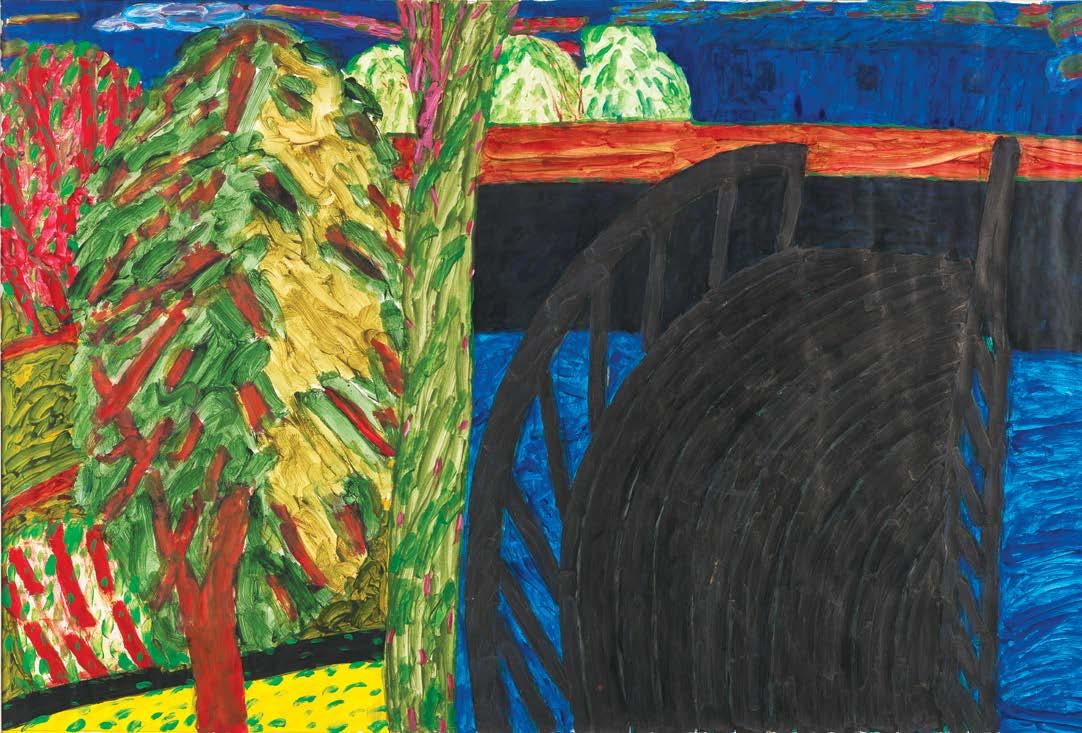
James Cumming was born in 1922 in Dunfermline, and educated at Dunfermline High School and Edinburgh College of Art. His studies were interrupted by war service in the Royal Air Force Volunteer Reserve and as a pilot trained in Texas. He served with Transport Command in India and Burma. He was a distinguished student and following his post graduate year and travelling scholarship, spent on the island of Lewis, he joined the staff of the painting school at the college, teaching painting and art history. He contributed to BBC radio and TV programmes on the arts and for several years was a member of the National Broadcasting Council for Scotland. As a painter he was possessed of a singular and highly personal vision. Several phases of interest took place in his work, Still Life, Portraits, Space Age, Puppets, Circus and the Electron Microscope brought forth another series of works concerning the visual nature of living cells. The hand of the draughtsman is always very much in evidence, an assured line in absolute control of the formal arrangement.
His most distinctive work of the 1960s is rich in colour, where it is employed, but is essentially tonal. He also displays a mastery of line, surface, and spatial concerns. In his choice of theme, he shows some residual sympathies with the work of Colquhoun and MacBryde, for example, as in the former’s Irish figure series of 1946 or the latter's still life, or with aspects of Scottie Wilson’s singular surrealism. His fourteen months on the Isle of Lewis c.1950, had a profound and lasting impact on his work, and his considered and meticulously wrought style is concerned with geometry, structure, and abstraction of form. As with his contemporary Joan Eardley, and the younger Alan Fletcher, lamp forms and tabletops are a recurring motif. His later career was more concerned with natural/cellular forms, vibrant colour, and more prominent geometry. He held solo exhibitions at The Scottish Gallery in 1962, 1971 and the Edinburgh Festivals of 1972 and 1985, as well as a major retrospective memorial exhibition at the Gallery in 1995 which continued to tour throughout Scotland.

James Cumming lived for more than a year in the remote island community of Callanish on the Isle of Lewis after being awarded a travel scholarship from the college in 1950. His residency lead to his acclaimed series of Hebridean paintings and much of his work shows inspiration from life on the island and the distinctive landscape of Lewis. As well as his Hebridean figurative work, he is noted for his still life compositions which are freely balanced between abstraction and figuration. In the 1960s he started to examine more geometrical and purer abstract themes and many of his later works derive from investigations into the Electron Microscope and his interest in microbiology and cellular structures as is apparent in this painting.
39. Tinker Family, 1985 acrylic resin, 61 x 49.5 cm signed lower right
exhibited James Cumming, Festival Exhibition, The Scottish Gallery, Edinburgh, 1985, cat. 17
James Cumming RSA, RSW (1922–1991)
James Cumming’s interest in the theme of puppets can be traced back to the early 1970s when a painting entitled Punch and Judy appeared with other new works which at the time hinted at a move away from cells and the microscope might be imminent. In the catalogue for his Middlesbrough Retrospective in 1987 he wrote: The puppet series was begun in 1972 with satire in mind, requiring near portrait likenesses which implied reality rather than defined it. The sequence grew to multinational characters, Dutch, Turkish or Indian, public or fictional figures.
Cumming had been in Inda in 1946 and Puppets, Poona includes the archetypes of the doe-eyed Tamil, an Anglo Indian of some importance and a caricatural Indian Army officer. Puppets, Poona was also the leading image for his Festival exhibition at The Scottish Gallery in 1985.
James Cumming RSA, RSW (1922–1991)
40. Puppets, Poona, 1985 acrylic resin, 61 x 51 cm signed lower left
exhibited James Cumming, Festival Exhibition, The Scottish Gallery, Edinburgh, 1985, cat. 17
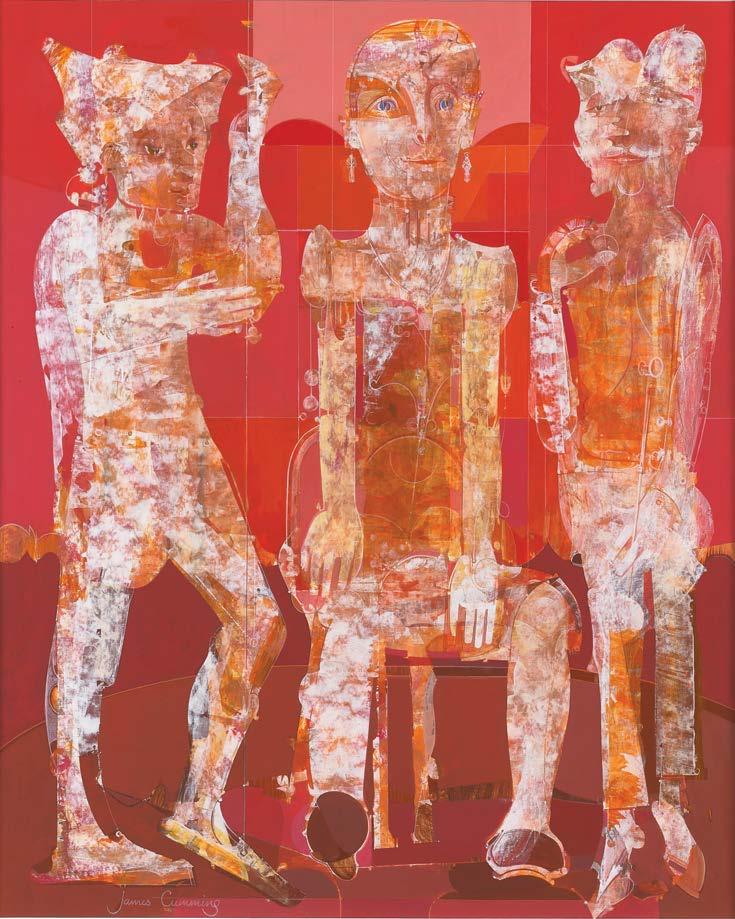
Sir William Gillies is widely regarded as one of Scotland’s greatest landscape and still life painters and has been one of the most important artists to The Scottish Gallery, holding seven solo exhibitions during his lifetime. Gillies was the dominant figure of the Edinburgh School over which both his personality and his work had a quiet authority. He led by example at the College of Art, encouraging his students to experiment but from a firm grounding in looking, and of course practice, drawing in particular. He also selected his staff to reflect this ethos: men and women who had a similar independence but respected hard work, what William MacTaggart called ‘the good habit.’ The duties of teaching for Gillies and many of his colleagues in the School of Drawing and Painting were combined with their own practice without conflict; being a professional painter: working and exhibiting, was understood as integral to the reputation and health of the
School. Robin Philipson, Elizabeth Blackadder, John Houston, David Michie and James Cumming were the beneficiaries of this attitude, along with their students, quietly instilled by Gillies over his fifty years of influence.
Gillies is still highly underrated in Modern British terms. He himself studied in Paris with André Lhote and absorbed, variously, the work of Munch, Matisse, Braque and Bonnard. Still life and landscape oils tend to be composed studio pieces of subtle complexity. Watercolours are lyrically observed renderings of the Scottish landscape based on decisive pencil or pen drawings or for larger works, executed alla prima. 2023 marks the 50th anniversary of Gillies’ death and The Gallery will be hosting a major exhibition of his work in June. Later this year the Royal Scottish Academy will present a touring exhibition of his work, coinciding with the release of a new monograph on the artist by Andrew McPherson.

Gillies paints a picture within a picture (on an easel) against a flat, pale board within an interior. In the picture, which is his and provides the whole subject for his second picture, there is perspectival space in which his pots, leaves and lamp consort in a series of rectangles and parabolic shapes. In this picture, depth is merely indicated by the shallow shadow of the easel crosspiece against the board. The playfulness and winning palette of creams, ochres and dun colour, make for an entirely satisfying composition. It derives from Braque, but is characteristic of Gillies’ spritely, crisp drawing with the brush and his wit and restraint in posing his subject. His upcycled frame is a typical, valuable addition to his time-derived aesthetic.
41.
exhibited
Sir William Gillies CBE, RSA, RA, PPRSW (1898–1973) Still Life with Lamp, c.1958 oil on canvas, 80 x 101 cm signed lower left Festival Exhibition, The Scottish Gallery, Edinburgh, 1958. cat. 4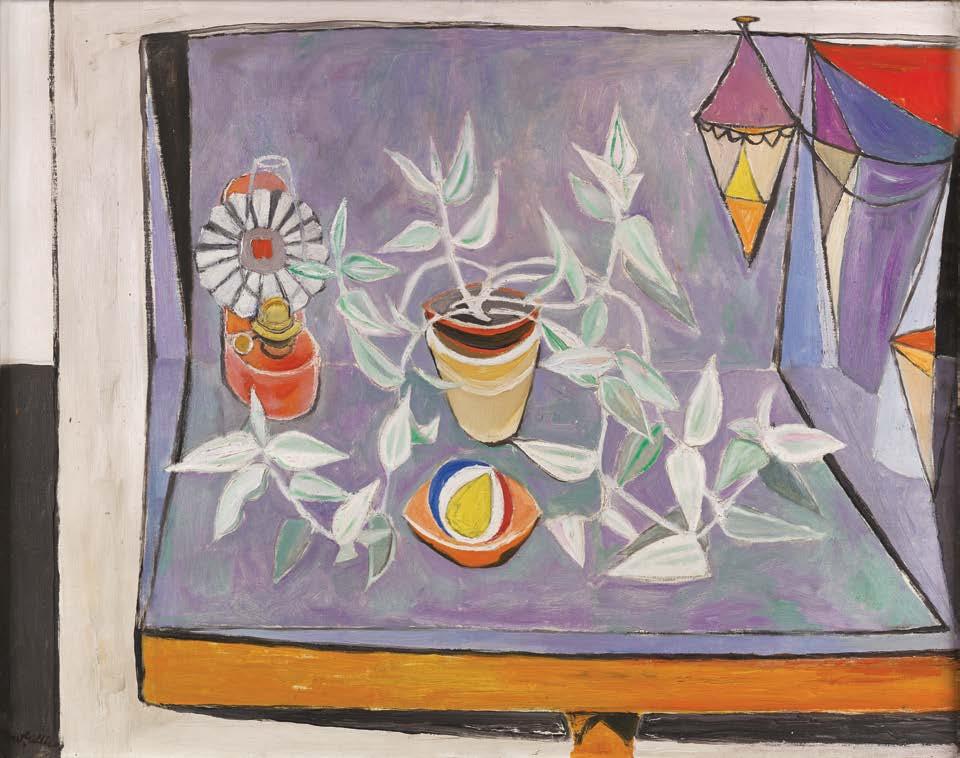
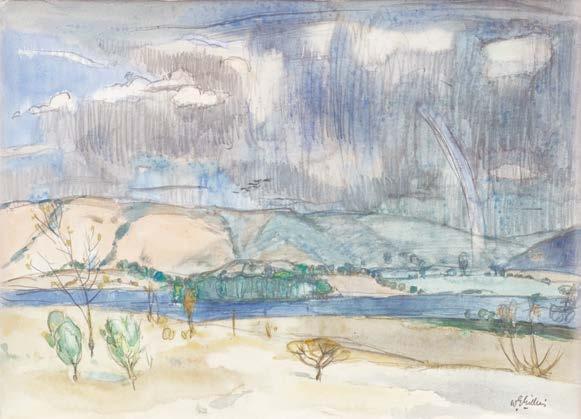 Sir William Gillies CBE, RSA, RA, PPRSW (1898–1973)
42. Moorfoots, c.1968 watercolour, 25.5 x 35.5 cm signed lower right
Sir William Gillies CBE, RSA, RA, PPRSW (1898–1973)
42. Moorfoots, c.1968 watercolour, 25.5 x 35.5 cm signed lower right
Sir William Gillies CBE, RSA, RA, PPRSW (1898–1973)
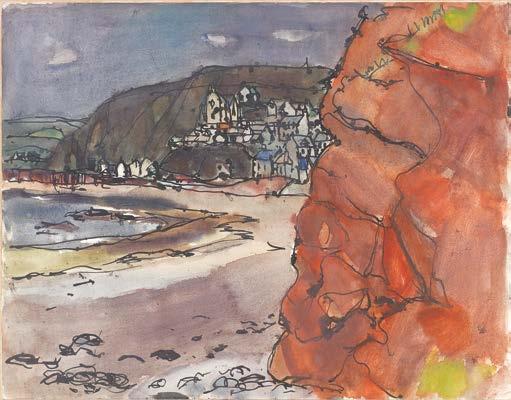
43. Gardenstoun, c.1948
watercolour, 24 x 31.5 cm
provenance
The Scottish Gallery, Edinburgh
Dawyck’s Haig had two studios in his home at Bemersyde Castle near Melrose in the Scottish Borders. One was modern, bright, lit from the north and generously proportioned; the other at the top of the original Tower House, a high room with minstrel’s gallery was more severe: a muscular space for his work in oils which are characterised by strong compositional building blocks and rich, earth-colours. His work on paper is altogether different in character. It is seldom pure watercolour in the English tradition (derived from Turner, who had painted the Castle on his Scottish tour of 1831) but rather relies on strong drawing, usually in pen, in a highly individual style full of nervous energy and washes of pure colour. Two of his artistic heroes can be credited with an influence. Firstly Paul Maze (1887–1979) who had been friend and mentor in his earliest period and whose freely painted, breezy watercolours are in a similar spirit, deriving from Impressionism and Raoul Dufy. Secondly William Gillies (whose work Lord Haig collected avidly) can be cited also for his commitment to the medium and ability to
see a picture where others might not. Haig did not seek out the drama of nature and even in Venice he preferred a backwater to the pictorial clichés of the Giudecca and St Mark’s. His depictions of a tumble of rocks and tangle of trees in the valleys around Orzes in the Veneto or preference for a view from the bank of the Tweed rather than the vista over the river towards the Eildons from Scott’s view, a mile from his home, speaks of a highly individual viewpoint. His preference as a landscape artist was always to work outside so that the practicality of watercolour as a medium was significant. What he gained from a direct engagement with his subject was spontaneity and, as with any plein air painter, his technique developed so that he could work quickly. It is the essential, abstract qualities of his subject which the artist seeks to paint and this without deviating from his desire to work truthfully makes Haig the quintessential modern landscape painter. His triumphant ninetieth birthday exhibition at The Scottish Gallery in 2008 and all too short a time later his Memorial show did much to secure his artistic legacy and reputation.
OBE, RSA (1918–2009) Earl Haig, c.1980.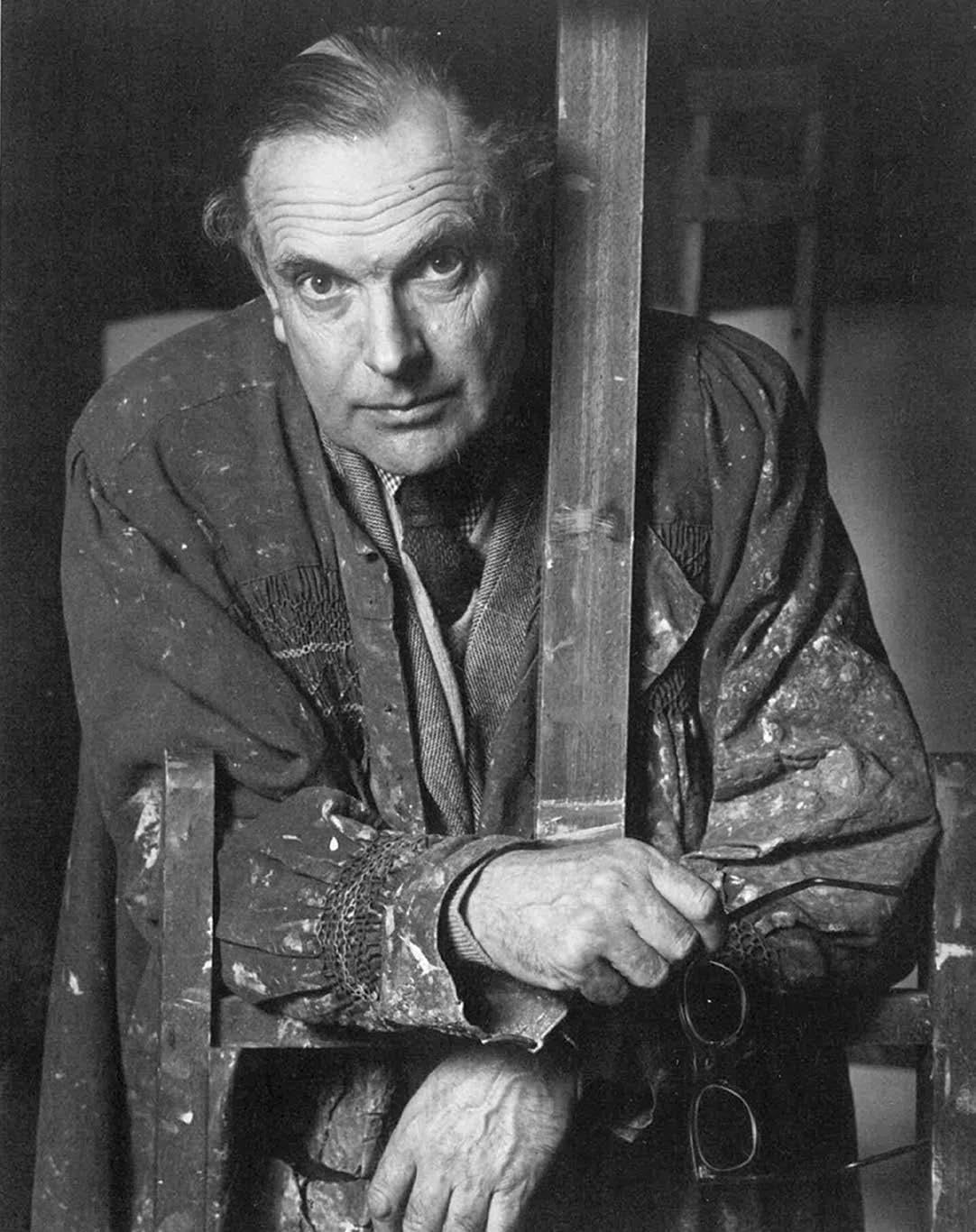
Haig found all of his subjects within a small radius, never travelling much outside the Scottish Borders except to Venice. Solving the problem of the most painted place on earth was the most liberating experience in Haig’s painting life. As he painted the Lagoon or Grand Canal (such as in Campo Santa Sofia) he confronted something which had always been difficult for him: space and light at the heart of his picture. The blues – some deep, some icy – and ochres of the Italian paintings soon made their appearance in the Borders’ scenes as well. Altogether it was a stimulating time in Venice, which encouraged unusual subjects.
Douglas Hall, Haig the Painter, 2003Earl
44. The Traghetto, Campo Santa Sofia, c.1985 oil on canvas, 71 x 91.5 cm signed lower right
exhibited Haig’s Venice, The Scottish Gallery, Edinburgh, 1991, cat. 7; Modern Masters Festival Edition, The Scottish Gallery, Edinburgh, 2022, cat. 14
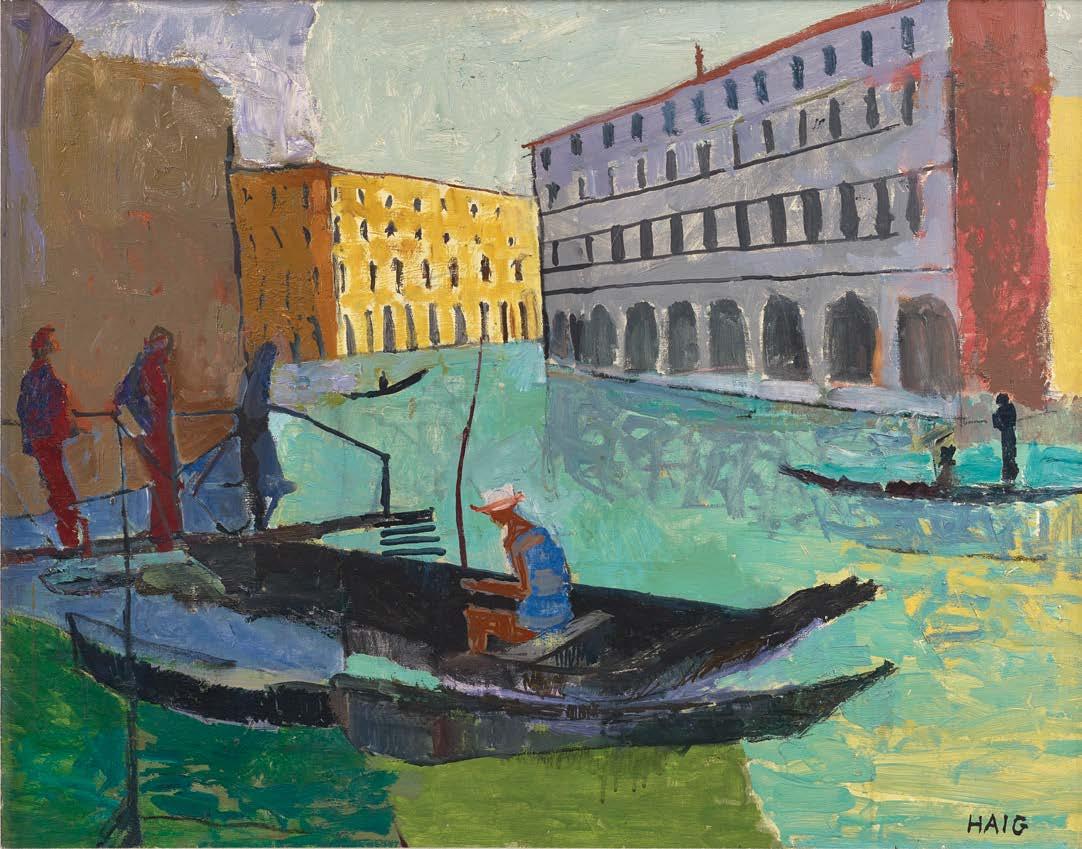
George Leslie Hunter stayed in California when his family returned to Scotland in 1898. He was already determined to be an artist and moved to San Francisco, the town Robert Louis Stephenson called the ‘Smelting pot of the races’. Someone else described it as ‘Montparnasse with six-shooters’. Hunter found studio digs in one of the terraces overlooking the panorama of the bay. Years later Hunter recalled his time with great affection, getting a square meal at the Hotel de France or Lola’s for fifteen cents, drawing constantly, finding his subjects in the music halls, street markets and theatres of China Town. He worked hard, joining the Californian Society of Artists – what Hunter’s biographer TJ Honeyman called the ‘Salon des Refusés’ of San Francisco, though it is not recorded that he ever sold a painting. He did derive an irregular income from commissions from newspapers and magazines and befriended the writers Bret Harte and Jack London for whom he also made illustrations. Hunter made a trip to Paris in 1904, returning via New York where he briefly kept a studio. He came back to hard work and the prospect of an exhibition. All hopes were dashed when his studio was destroyed in an earthquake on the 18th of April 1906. Hunter was out of town, but
was left with no more than the clothes he wore and the contents of his weekend bag.
Marigolds, surely the most precocious member of the Daisy family, were a favourite subject of George Leslie Hunter. T. J. Honeyman, Hunter’s biographer and at the time a partner in the firm of Reid & Lefevre, recalled a visit to the Gallery by Clive Bell who completed a tour of inspection and pointed to a still life of marigolds in the corner: ‘That is the finest picture in the exhibition, and I don’t know who painted it.’ From this Honeyman determined to write his book Introducing Leslie Hunter, published by Faber in 1937. Hunter had his first show with Alexander Reid in Glasgow in 1916, a show well received and supported. He was living on his uncle’s farm near Larkhall, trying to get himself fit for the dreaded call-up. His still lifes from this time are fresh, direct paintings which have something of the expressionist joy of Matisse rather than the analysis of Cubism. His palette is white based, his impasto rich and application confident as he emerges from his Dutch or Spanish influenced work to a place where his work chimes with Peploe and Cadell as one of the four Scottish Colourists.
45. A Still Life with Fruit and Flowers, c.1922 oil on canvas, 65 x 54 cm signed lower left exhibited Modern Masters Festival Edition, The Scottish Gallery, Edinburgh, 2022, cat. 17

After War service on the Western Front, Milne sought change and new inspiration in France where he spent most of the 1920s. His earlier work, derived from his father and uncle’s breezy, naturalistic styles, gives way to strong colour and a planar analysis of form. In this sense he is without question allied with the Scottish Colourists, all artists able to respond in new ways to a changed world after the Great War.
Milne first spent time in the Loire valley but was in Cassis in 1924 at the same time as Peploe and Cadell before venturing further along the côte to St Tropez for the first of many visits, then not much more than a fishing village. Here he made some of his most brilliant, and popular paintings, suffused by the Mediterranean light.
John Maclauchlan Milne (1885–1957)
46. St Tropez, c.1926 oil on board, 33 x 40 cm signed lower left
exhibited
John Maclauchlan Milne, Centenary Exhibition, Dundee Museum and Art Galleries, 1985
provenance
Cyril Gerber Fine Art, Glasgow
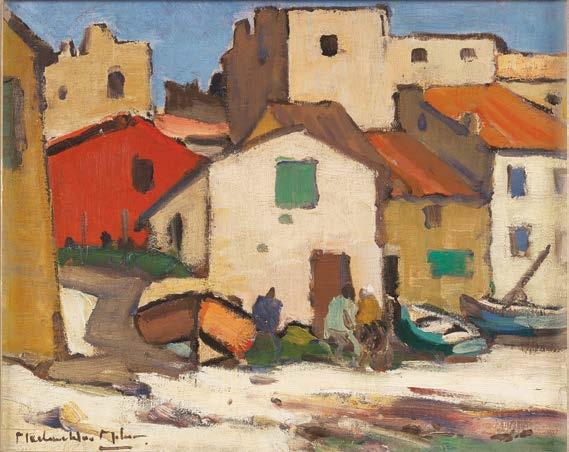
RSA, RSW (1932–2020)
From the late 1970s, James Morrison painted on the Argyll coast and at Morar, moving further north to Wester Ross and to the Assynt region, with Sutherland to the north and the Torridon Mountains to the west. He was astonished by the primeval landscape and came to understand the meaning of the term ‘Celtic Twilight’. All these observations and sensations were derived not merely from the actual landscape but from Morrison’s penetrating vision of the land, sea and sky. The View from Morar reflects the kaleidoscope of islands and shifting weather. This painting was acquired from the artist’s Festival exhibition with The Gallery in 1984 and was featured in the 1985 BBC programme Morrison at Work
James Morrison RSA, RSW (1932–2020)
47. View from Morar, 27.VI.83 oil on board, 72 x 143 cm signed and dated lower right
exhibited James Morrison, Festival Exhibition, New Landscapes, East and West Coasts, The Scottish Gallery, Edinburgh, 1984, cat. 13

Alberto Morrocco paints in a room with Venetian blinds. He has no need of the view. In his 18th century ivy covered house in Dundee with its bonny garden and view of the hump-backed railway bridge across the Tay, Morrocco paints a beach full of blue umbrellas a hot, bustling Lido near Genoa. The landscape of Scotland with its soft hills and mists and damp green is not Morrocco’s scene. He is a man of Mediterranean blues and though he spends most of his time out of the heat at home in Scotland, his work is full of it. Born of immigrant Italian parents in Aberdeen, Morrocco took to the double life naturally. A training under James Cowie and a long, respected teaching career as Head of Painting at Duncan of Jordanstone College, Dundee, equipped him with a Scottish skin. Not cooled by this camouflage, his senses remained true to his southern origins. In his work, red courses through the still lifes of plump pears, the arms of ripe women and the flesh of watermelons are swept up in Italian pink, orange, cerise and fuscia in exotic combinations. Frames within frames and open windows create an ambiguous space.
Objects in his studio like a green and yellow plate, a bright plastic orange and a dusty bird in a wooden cage appear over and over again, their shapes formalised with Matisse-like rhythms and their colour balanced with the harmonics of a fauve. Aberdeen seemed an unlikely spot to nurture his Italian connections, but Morrocco was quick to disagree. He described it as a cold but nicely ordered city and in a neo-classical building he and a handful of other students took class rather in the way a Renaissance apprentice might learn from a master. Ego and spirit unchecked by examinations (there were none) Morrocco came out of education with his twin nationality and temperament intact. Two self-portraits which lay against a pile
of books in Morrocco’s sitting room attested to this lifelong duality. One, in Scottish painterly style, showed a fresh-faced young man aged 16 in gentle, country colours. The holes were added later by his children’s enthusiasm for darts. The other portrait added the years of experience. In cardinal red, side-on, Morrocco is sharply Italian, in proud quattrocento pose. Unwilling to relinquish his Italian inheritance, Morrocco was a great traveller from the 1930s. Because of the War, France and Switzerland came first, but Italy was inevitably to become the destination for many holidays and study trips later in his career. Drawings were made in profusion on these outings, providing a store of subjects for paintings made back in the studio in Scotland. Beach huts and tans on sand materialised from life studies often observed years previously. There was a crowded beach near Palermo, a street where he bumped into the watermelon sellers and a place near Rome where the ladies hung languidly from their windows. Morrocco brought these all home and framed them full colour. Perhaps it was Scotland itself which brought out the Italian in him.
 alice bain
Writing for Alberto Morrocco, Festival Exhibition at The Scottish Gallery, 1987
Alberto Morrocco in his studio, Dundee, 1996.
Photograph by Chris Close
Opposite: Alberto Morrocco’s studio, Dundee, c.2017.
alice bain
Writing for Alberto Morrocco, Festival Exhibition at The Scottish Gallery, 1987
Alberto Morrocco in his studio, Dundee, 1996.
Photograph by Chris Close
Opposite: Alberto Morrocco’s studio, Dundee, c.2017.
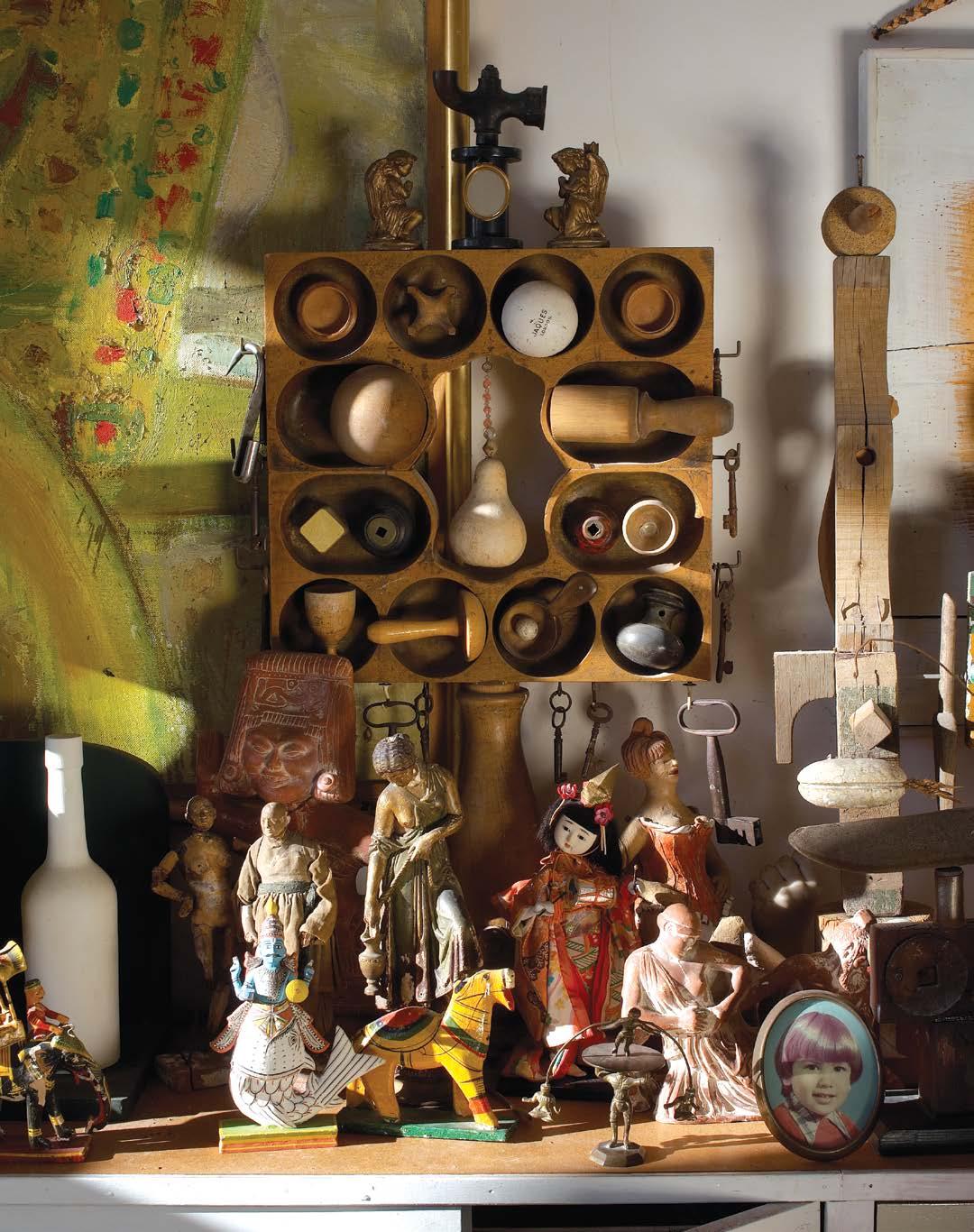
Morrocco had always carried a sketchbook in Italy, making swift, decisive observations of whatever presented itself as interesting. Looking like a benign version of Picasso, in a horizontally striped shirt, neckerchief and broad smile, no one would object to the artist making a quick sketch. These drawings were put to the best possible use in the last decade of his life; ideas a-plenty to start the business of painting. In earlier decades he tended to deploy more traditional techniques with preparatory drawing and underpainting, and his colour was always personal but under restraint. Now he let loose: brilliant reds, blues, oranges, veridian and vermillion. Still life, beach scenes, sometimes combined, Italians at play, a dog listless in the noonday heat.
In Two Women at a Window, Picasso’s Classical period is present but fully absorbed into Morrocco’s playful, elysian Italy, a painting full of warmth, sensuality, and gentle humour.
48. Two Women at a Window, 1987 oil on canvas, 81 x 76 cm signed and dated upper left
Alberto Morrocco OBE, FRSA, FRSE, RSW, RP, RGI, LLD (1917–1998)
I have painted still life off and on throughout my career but I really started concentrating on it about fifteen years ago… I became much more conscious of the formal values that a still life can actually give freedom for – so that I began to look at still life from this point of view, not simply depicting a few apples or oranges or a couple of jugs and so forth, as a kind of theme – but simply the relationship of the shape of a jug to the shape of a compote or the shape of a pear or the colour of a few objects on a white tablecloth against something in the background. You can actually use the shapes within a still life just as you would in any abstract because they don’t necessarily have to tell any story – apart from their own existence. From that point of view I think it’s a very valuable part of any contemporary artist’s work, if he or she is a figurative painter.
alberto morrocco, 199749.
Alberto Morrocco OBE, FRSA, FRSE, RSW, RP, RGI, LLD (1917–1998) Still Life with Bluebird – Night, 1981 oil on canvas, 71 x 76 cm signed and dated upper left; signed and title inscribed on artist’s label verso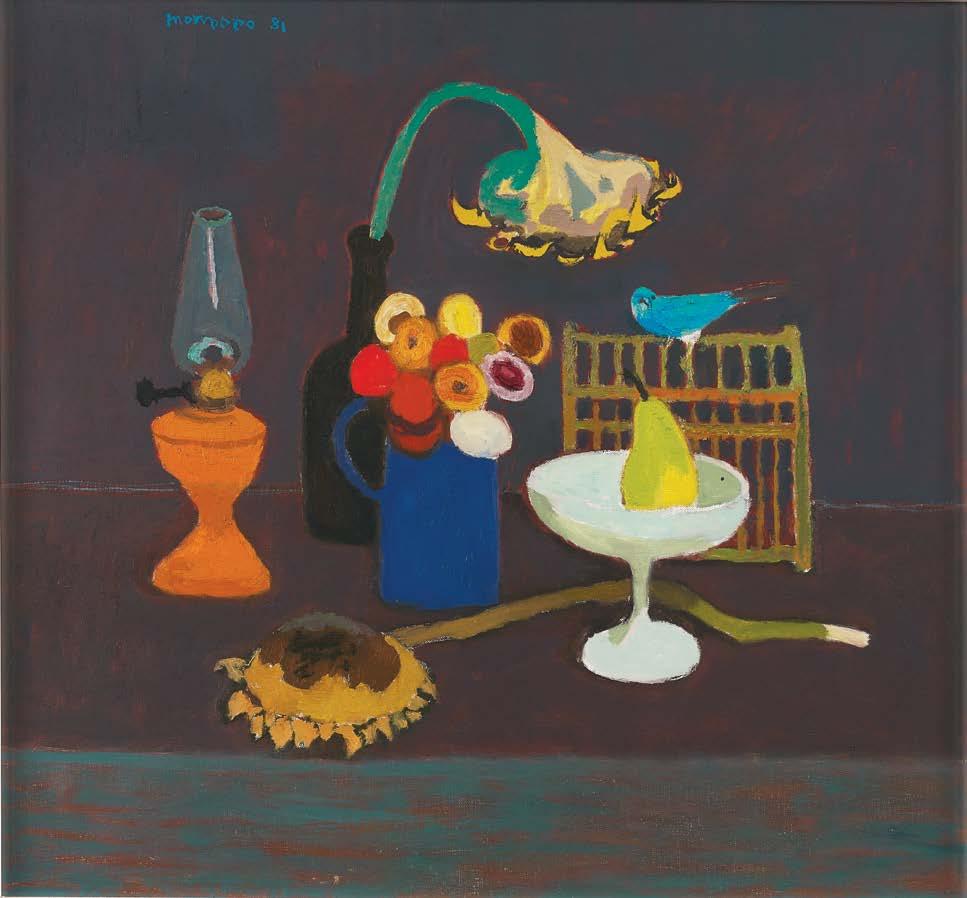
Anne Redpath was the pivotal figure in the group of painters now referred to as The Edinburgh School. Born in Galashiels in 1895 and brought up in Hawick, she attended Edinburgh College of Art, receiving her diploma in 1917. Travel was a source of inspiration for Anne Redpath throughout her life. In 1947, she visited Menton in the south of France, where she painted and sketched extensively. Menton is 20 miles north east of Saint-Jean-Cap-Ferrat, where Redpath had lived with her architect husband James Michie and young family during the 1920s, before returning to her native Scottish Borders in 1934. She had considerable commercial success in her lifetime, enjoying a fruitful, consistent relationship with The Scottish Gallery and latterly with Reid & Lefevre in London. Since her passing, her reputation has been further enhanced with retrospective and centenary exhibitions, so that now she is established as one of the great figures in 20th century Scottish painting.
50. A Mediterranean Port Scene, c.1947 watercolour and gouache, 36
cm signed lower right
provenance
Bourne Fine Art, London & Edinburgh; The Scottish Gallery, Edinburgh
OBE, RSA, ARA, RWA (1895–1965) Anne Redpath OBE, RSA, ARA, RWA (1895–1965) x 49
OBE, RSA, PRSW (1885–1976)
Adam Bruce Thomson was a diligent artist. Despite his long vocation as a teacher at the Edinburgh College of Art and devotion to family, he worked at every opportunity. This would come in abundance on the long summer holidays where in the wilds of Argyll or the islands, subjects like the shearing would present a challenge, readily taken up. But in Edinburgh, he would walk most days in the green spaces on the South side: the Braids, Arthur’s Seat, Blackford Hill and Colinton. In the studio at home he would paint the family and still life in both oil and watercolour, his gift of having survived the Great War repaid in diligence and creativity.
Adam Bruce Thomson OBE, RSA, PRSW (1885–1976)
51. Fruit in a Bowl, c.1950 oil on board, 29.5 x 39.5 cm signed lower right
exhibited
A Centenary Exhibition, The Scottish Gallery, Edinburgh, 1985, cat. 20
provenance
The Artist’s Studio Inventory no. O20 stamp verso

David Toner was born in Glasgow. He was educated in both Glasgow and Changi, Singapore, and studied at the Glasgow School of Art under David Donaldson and James Robertson in the mid-1970s. He specialises in mixed media. His work is mainly characterised by the depiction of buildings and October Evening is a classic example of his work which was acquired from his solo exhibition at The Scottish Gallery in 1985.
52. October Evening, Montparnasse, c.1985 oil on canvas, 34 x 34 cm signed lower left
David Toner (b.1944)
Published by The Scottish Gallery to coincide with the exhibition
A COLLECTOR’S EYE
4–27 May 2023
Exhibition can be viewed online at www.scottish-gallery.co.uk/acollectorseye
isbn: 978-1-912900-65-7
acknowledgements
The Scottish Gallery wishes to thank the Eccleston and Lockhart families for their help with this exhibition. Thanks also to John McKenzie, Becky Thomson and the Walker estate for the use of archive images.
production The Scottish Gallery
design Kenneth Gray
photography John McKenzie
print Pureprint Group
All rights reserved. No part of this catalogue may be reproduced in any form by print, photocopy or by any other means, without the permission of the copyright holders and of the publishers. All essays and picture notes copyright The Scottish Gallery.
Cover: Alberto Morrocco, Two Women at a Window, 1987, oil on canvas, 81 x 76 cm (cat. 48) (detail)
Inside front cover: Denis Peploe, Still Life with Flowers, c.1975, oil on canvas, 61 x 48 cm (cat. 27) (detail)
Right: Sir William Gillies, Still Life with Lamp, c.1958, oil on canvas, 80 x 101 cm (cat. 41) (detail)
